- What is the SAP Business One Integration Tool Pack?
- Video Overview
- White Paper - SAP Business One Integration Tool Pack v3.12
- Architecture
- About the SAP Business One Trigger Tool
- About the SAP Business One (DIAPI) Integration Tool
- About the SAP Business One (DIAPI) Integration Agent
- About the SAP Business One (SL) Integration Tool
What is the SAP Business One Integration Tool Pack?
The SAP Business One Integration Tool Pack allows you to automate the management of your SAP Business One company data.
You can carry out tasks such as retrieving information from a company or executing an operation to automatically ADD, UPDATE, or DELETE items such as invoices, sales orders, or business partners. Company objects and fields can be mapped to BPA Platform data at runtime.
When combined with other tools of BPA Platform, the SAP Business One Integration Tool Pack can also provide a method of synchronising data between two systems that do not naturally talk to each other; for example, your SAP Business One system and a web shop such as Magento.
The SAP Business One Integration Tool Pack Contents
The tool pack consists of:
- SAP Business One Event Agent
- SAP Business One Trigger tool
- SAP Business One (DIAPI) Integration Agent
- SAP Business One (DIAPI) Integration tool
- SAP Business One (SL) Integration Agent
- SAP Business One (SL) Integration tool
SAP Business One Connector Features
- On-premise and cloud (both Public and Private Cloud) installations of SAP Business One supported.
- Support for user defined tables and fields within objects and sub-objects.
- Allows you to maintain the synchronisation of data between one SAP company database and another. For example, if a record changes in one company it will be reflected in the other.
- Allows data to be synchronised between SAP Business One and third-party systems.
- Dynamic provision of API metadata enabling changes to objects & operations to be rolled out independently of the tool pack (SAP Business One (DIAPI) Integration tool only).
- Memory support for ODBC, OLEDB, Call Store Procedure, and internal repositories (SAP Business One (DIAPI) Integration tool only).
Video Overview
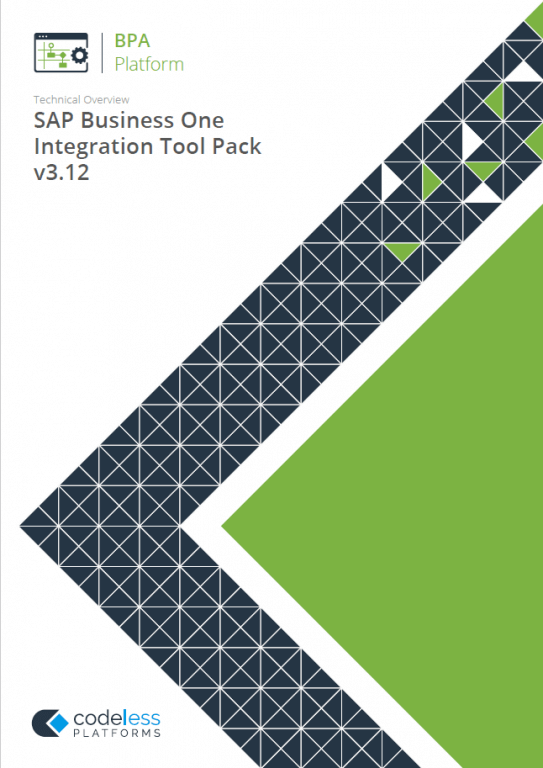
White Paper - SAP Business One Integration Tool Pack v3.12
System Requirements
All aspects of the SAP Business One Integration Tool Pack require BPA Platform (formerly known as “TaskCentre”) 2020 Update 1 (build 6466) or above.
The supported versions of SAP Business One are as follows:
| Version | Supported with SQL Server | Supported with SAP HANA |
|---|---|---|
| SAP Business One 8.82 | ||
| SAP Business One 9.0 | ||
| SAP Business One 9.1 | ||
| SAP Business One 9.2 | ||
| SAP Business One 9.3 | ||
| SAP Business One 10.0 |
For more information about SAP Business One compatibility, refer to your Codeless Platforms partner or account manager.
Architecture
The following diagrams demonstrate the possible architectures when using the SAP Business One Integration Tool Pack with either an SQL Server or SAP HANA configuration. The following combinations of tool pack components are valid:
- SAP Business One (DIAPI) Integration Agent and tool
- SAP Business One (SL) Integration Agent and tool
- SAP Business One (DIAPI) Integration Agent and tool and the SAP Business One (SL) Integration Agent and tool
- SAP Business One Event Agent, SAP Business One Trigger tool, and SAP Business One (DIAPI) Integration Agent and tool
- All six components
SAP Business One On-Premise Configurations
The following diagrams provide an architectural overview of supported SAP Business One Integration Tool Pack components in an SAP Business One on-premise environment. This includes configurations where the BPA Platform server is located in the same network as SAP Business One, or where BPA Platform is partner-hosted in the cloud and the SAP Business One instance resides on-premise in an external customer network.
Using a Microsoft SQL Server Configuration in the Same Network
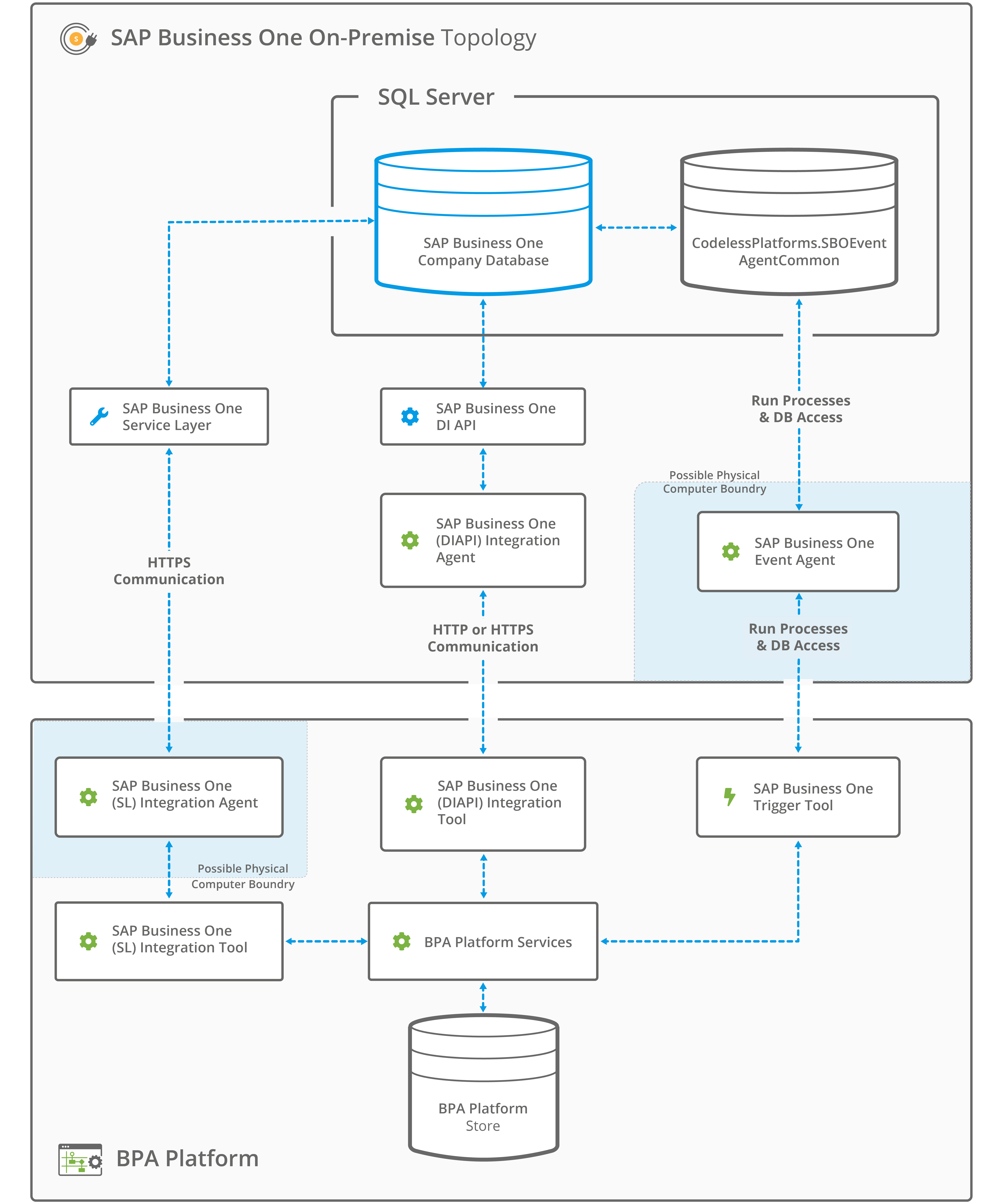
To monitor SAP Business One events, the SAP Business One Event Agent can be located on the same computer hosting the required company database instance — remote installations are supported.
The same applies to the SAP Business One (SL) Integration Agent. However, the SAP Business One (DIAPI) Integration Agent must always be located on the same computer hosting the SAP Business One Data Interface API (DIAPI); remote installations are not supported for this Agent.
The SAP Business One Trigger, SAP Business One (DIAPI) Integration and SAP Business One (SL) Integration tools must be installed on the BPA Platform server, and also on any remote BPA Platform client computers (not shown) that run SAP Business One tasks.
Using an SAP HANA Configuration in the Same Network
As before, all Agents can be located on the same computer hosting the connecting service with the exception of the SAP Business One (DIAPI) Integration Agent which must be located local to the DI API service.
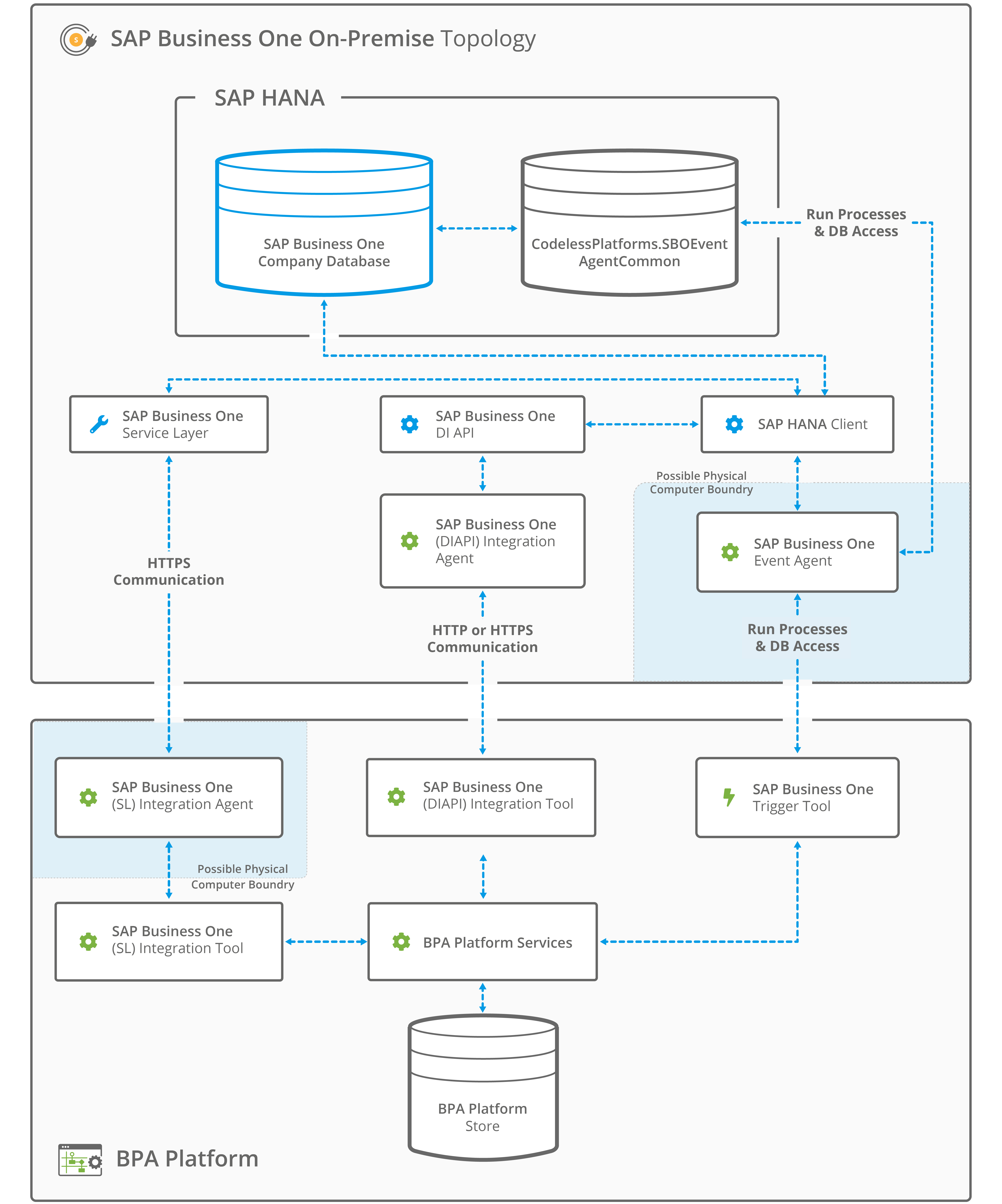
The SAP Business One Trigger, SAP Business One (DIAPI) Integration, and SAP Business One (SL) Integration tools must be installed on the BPA Platform server, and also on any remote BPA Platform client computers that run SAP Business One tasks.
Using a Partner-Hosted Cloud Instance of BPA Platform with On-Premise SAP Business One with SQL Server
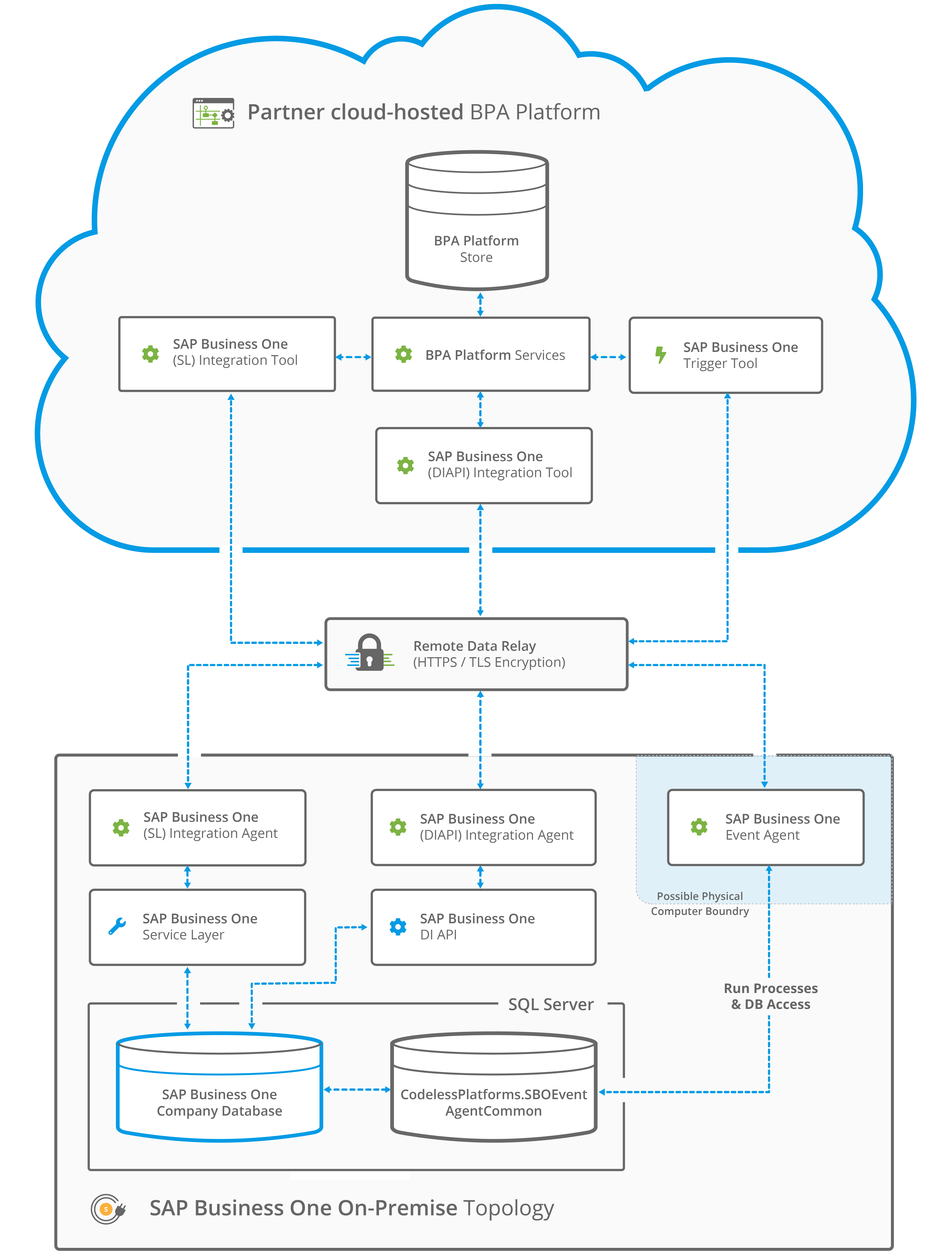
The diagram (above) describes the architecture between a single BPA Platform instance and one SAP Business One company database, however this can be scaled to include multiple BPA Platform instances connecting to multiple SAP Business One databases for different customers.
Where BPA Platform is hosted in the cloud by a partner for example, and SAP Business One exists on-premise in a customer’s external network, connectivity can be established using our Remote Data Relay. This enables secure communication between the customer’s BPA Platform instance and their on-premise SAP Business One company database. The Remote Data Relay can be most effectively used in environments where multiple cloud-hosted BPA Platform instances reside on a single Windows Server and connectivity is required to one or more BPA Platform company databases located in one or more external networks.
The SAP Business One Trigger, SAP Business One (DIAPI) Integration and SAP Business One (SL) Integration tools must be installed on the BPA Platform server, and also on any remote BPA Platform client computers (not shown) that run SAP Business One tasks.
SAP Business One Cloud Configurations
The following diagrams provide an architectural overview of supported SAP Business One Integration Tool Pack components with SAP Cloud.
SAP Private Cloud with Microsoft SQL Server
The BPA Platform server must be installed on a computer which is in the same secure domain and has access to the SAP Presentation Server, for example an Application Server, or on the Presentation Server itself.
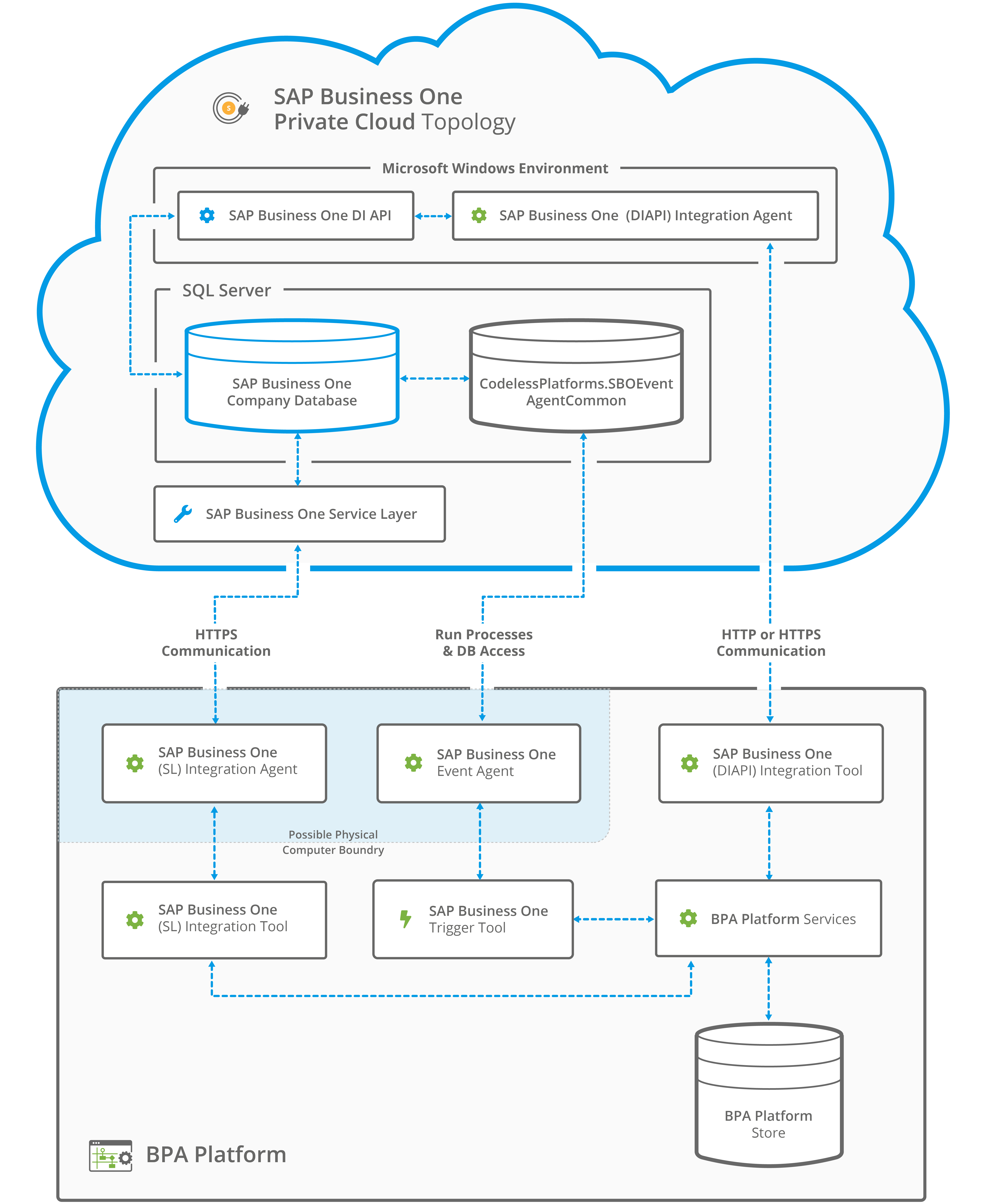
The SAP Business One Event Agent can be installed on the same computer as the BPA Platform server, or on any remote computer in the same secure domain which has access to both BPA Platform and the relevant SAP Business One company database in the Private Cloud environment.
The same applies to the SAP Business One (SL) Integration Agent. However, the SAP Business One (DIAPI) Integration Agent must be installed along-side the SAP Business One DIAPI therefore the cloud environment must make a computer available for both components.
The SAP Business One Trigger, SAP Business One (DIAPI) Integration, and the SAP Business One (SL) Integration tools must be installed on the BPA Platform server, and also on any remote BPA Platform client computers (not shown) that run SAP Business One tasks.
SAP Private Cloud with SAP HANA
The BPA Platform server must be installed on a computer which is in the same secure domain and has access to the SAP Presentation Server, for example an Application Server, or on the Presentation Server itself.
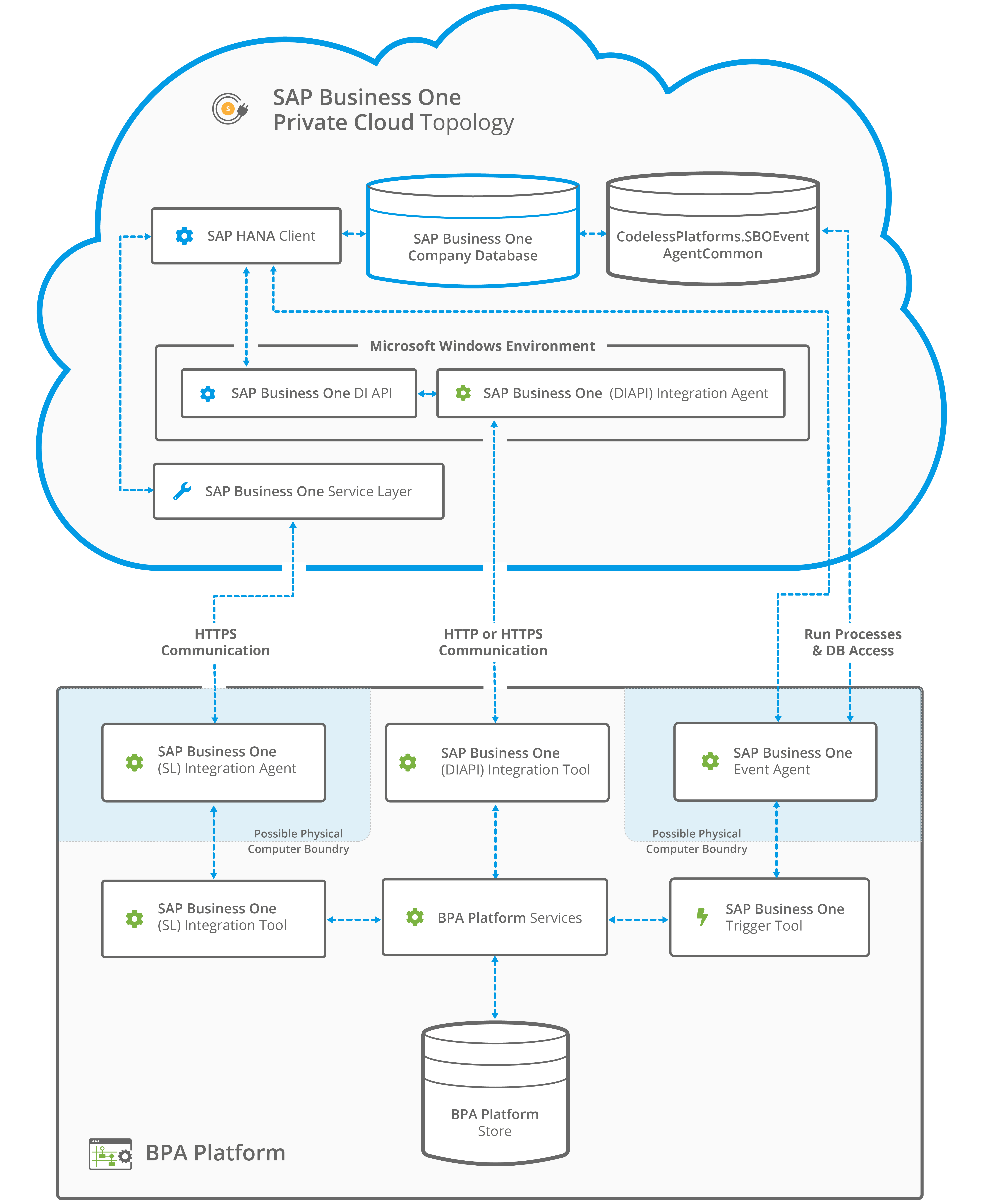
The SAP Business One (SL) Integration Agent can be installed along-side the BPA Platform server or a remote computer (in the same secure domain) that has access to both BPA Platform and the Service Layer.
The SAP Business One Event Agent can also be installed on the BPA Platform server or a remote computer but must have access to the SAP HANA client.
The SAP Business One (DIAPI) Integration Agent, however, must be installed along-side the SAP DI API cloud environment must make a computer available for both components.
The SAP Business One Trigger, SAP Business One (DIAPI) Integration, and SAP Business One (SL) Integration tools must be installed on the BPA Platform server, and also on any remote BPA Platform client computers that run SAP Business One tasks.
SAP Public Cloud
With a SAP Public Cloud environment, only a SAP Business One (SL) Integration Agent and tool deployment is supported. The SAP Business One Event Agent cannot be deployed in this environment as triggers are not permitted by SAP Business One. All communication is over HTTPS.
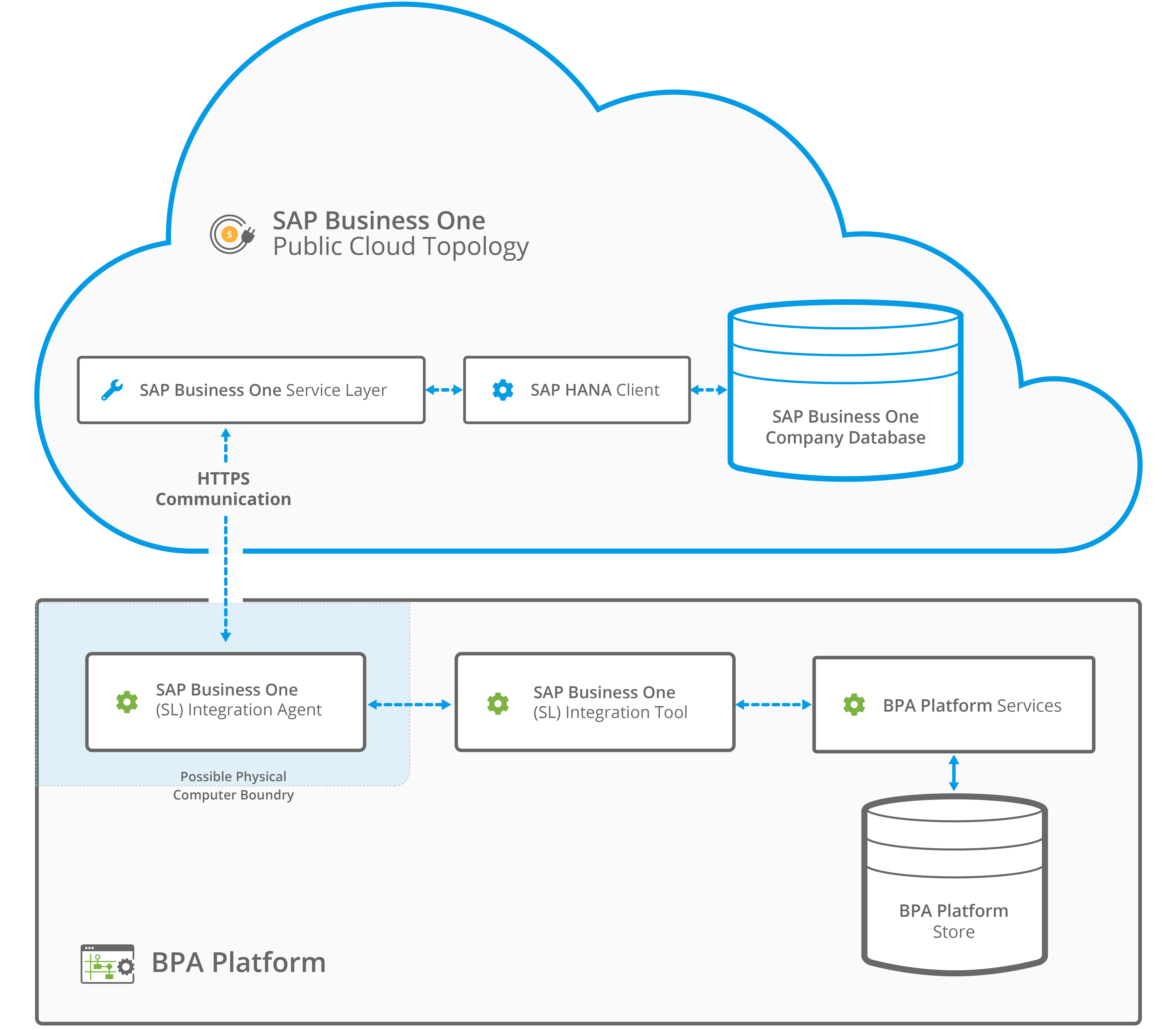
The BPA Platform server must be installed on a computer which is in the same secure domain and has access to the SAP Presentation Server, for example an Application Server, or on the Presentation Server itself.
The SAP Business One (SL) Integration Agent can be installed along-side the BPA Platform server or a remote computer (in the same secure domain) that has access to both BPA Platform and the Service Layer.
About the SAP Business One Trigger Tool
The SAP Business One Trigger tool is used to trigger a task when the contents of a SAP Business One database are modified, monitored by the SAP Business One Event Agent.
You can select which object to trigger on and also define when the trigger will fire based on the type of event the object receives, that is, an ADD, UPDATE, DELETE, CANCEL, or CLOSE.
You can even restrict an UPDATE trigger to an event that occurs to a field of an object instead of having a task trigger when any field receives an event (only if the object type supports history data).
Variables are used in the tool to capture any data being inserted, removed, or updated. This data can then be passed to other steps in the task for processing.
Additionally, where an update is being applied to a field, you can choose to capture the before and after values which can also be passed to subsequent steps in the task (only if the object type supports history data).
About the SAP Business One Event Agent
The SAP Business One Event Agent is a service that monitors a SAP Business One company database for specific events. Once an event has been detected, it notifies the SAP Business One Trigger tool to trigger a task sequence. You configure the triggering event types in the tool itself.
The location of the SAP Business One Event Agent installation depends on the database environment:
- If installing to a Microsoft SQL Server environment, the SAP Business One Event Agent is typically located onthe same server running the SAP Business One company database instance it is monitoring. This is the recommended installation.
However, remote SAP Business One Event Agents (where it is installed on a separate computer to the company database) are supported, particularly where the company database is hosted in a cloud environment.
- If installing to a SAP HANA environment, the SAP Business One Event Agent must be located on the same server hosting the SAP HANA Client instance for the company database it is monitoring. Installing the Event Agent directly onto the SAP HANA Server is not supported.
Again, remote installations of the Event Agent are supported, particularly in cloud environments.
The SAP Business One Event Agent can be configured to work within the same network (which is the standard implementation) or, if BPA Platform is operating within a cloud-hosted environment, it can be set up to connect to an on-premise instance of SAP Business One operating in an external network using our Remote Data Relay.
When registered, the Event Agent creates its own database table, CodelessPlatforms.SBOEventAgentCommon, containing records of the events which the SAP Business One Trigger tool then reads. Specific user credentials are required for this — refer to the product help.
After the installation has completed, the BPA Platform Configurator is launched for immediate configuration — refer to the product help.
Technical Summary
Global Configuration for the SAP Business One Trigger Tool
No global configuration is required for the SAP Business One Trigger tool.
Instead, you create a connection to the SAP Business One Event Agent then to the SAP Business One company database through the BPA Platform Configurator.
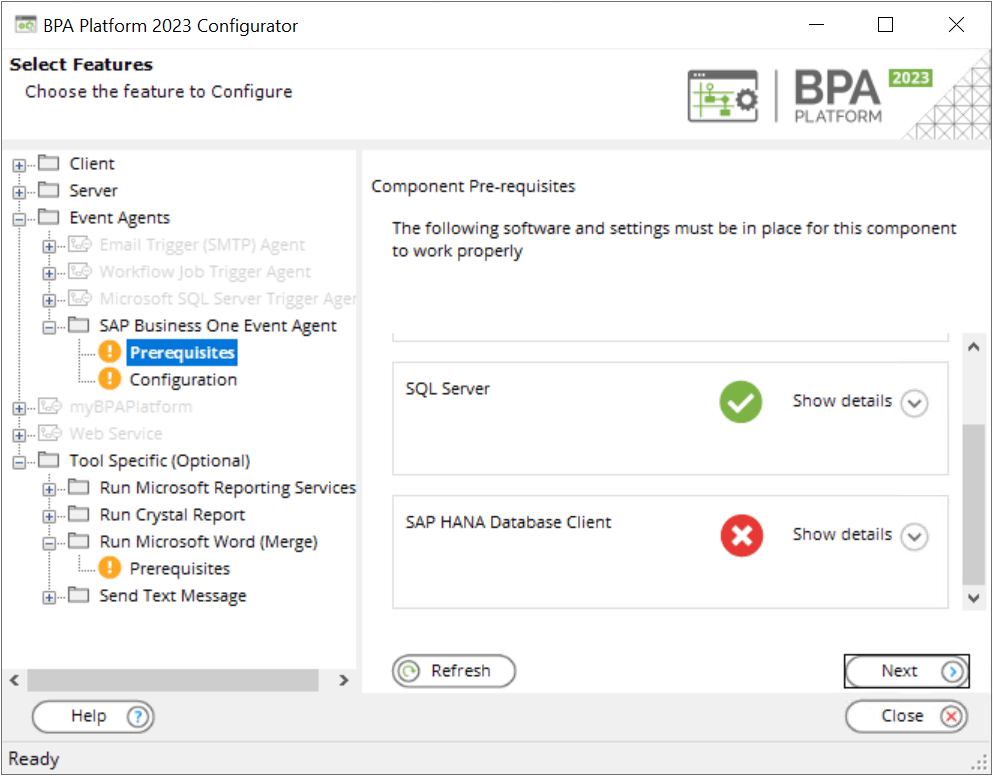
For a detailed description of how to use the Configurator and how to create the connection, refer to the product help.
Working with Other Tools
The SAP Business One Trigger tool is independent of any other steps used in a task.
Objects Consumed
Because the SAP Business One Trigger tool starts tasks, it does not consume any objects exposed by other task steps.
Objects Exposed
The SAP Business One Trigger step exposes the following objects, which can be used by other task steps:
- Step Properties — Standard step properties are exposed allowing you to use statistical data of the SAP Business One Trigger step.
Step Configuration
When creating new tasks, the SAP Business One Trigger tool is located under Event of the Task Browser.
To add a new SAP Business One Trigger step to an existing task, do the following:
From the relevant task, either:
- Click and drag the SAP Business One Trigger icon from the Task Browser to the task Design area.
- From the task’s Design tab, right-click on empty space and select New > Event > SAP Business One Trigger.
For a detailed description of how to create new tasks, refer to the product help.
About the General Tab
The General tab is used to Name and describe (Description) this task step.
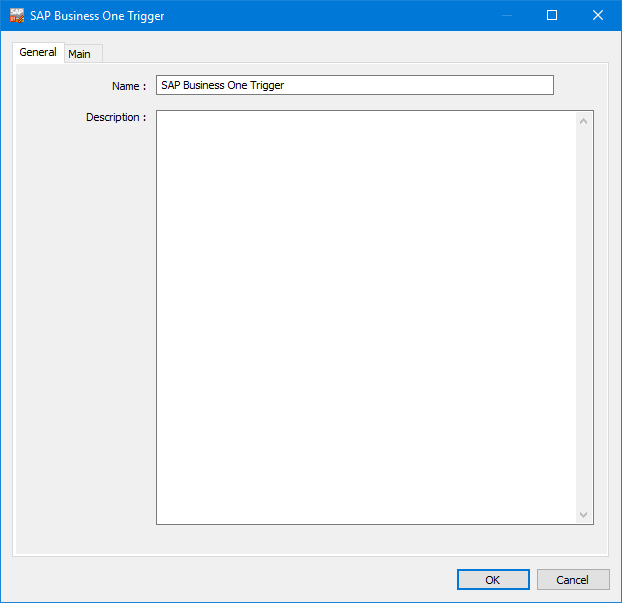
About the Main Tab
The Main tab is used to select the SAP Business One database to monitor and the criteria required to trigger the task to run.
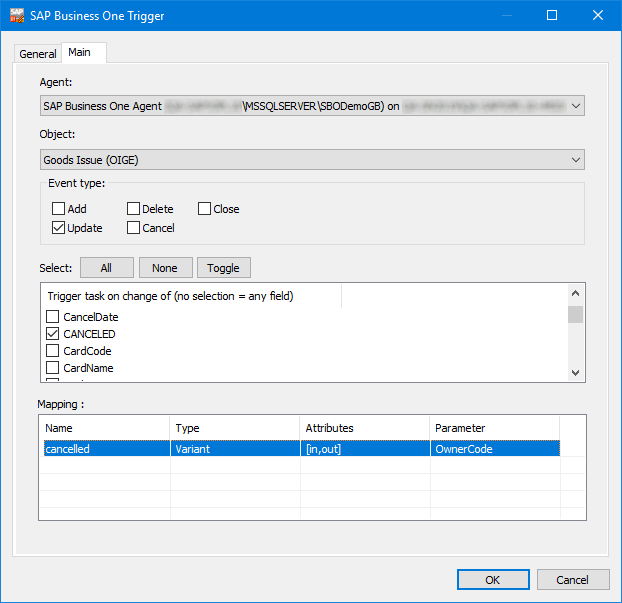
From the Agent drop-down list, select the relevant SAP Business One Event Agent monitoring the company database. If multiple Agents are registered with this instance of BPA Platform, the monitored company database is also shown.
The Object drop-down list is populated with the SAP Business One objects from the monitored company database. From the drop-down list, select the object used as the trigger.
Choose the Event Type used as the trigger (multiple Event Types can be selected):
- Add — The step is triggered when a new record is added to the Object
- Delete — The step is triggered when an existing record is deleted
- Close — The step is triggered when an existing record is closed
- Cancel — The step is triggered when an existing record is cancelled
- Update — The step is triggered when an update occurs for an existing record
- Select the relevant field(s) to trigger on
- Click All to trigger when all fields for that object are updated
- You can also create Update triggers on a specific field for an object.
Either:
Use None to clear the selection of all fields. Having no fields selected means the step triggers when ANY field is updated for that Object.
Use Toggle to switch between all fields selected and none.
previousValue field. Note that only those objects that provide history data have the previousValue field.Use the Mapping panel to map parameter-type task variables to an Object field. These variables can then be used in another task step. All relevant variables are shown under Name. Use the Parameter drop-down to map to the relevant field.
Supported Objects
At the time of writing, you can place triggers on the following objects. Those objects that allow Update triggers to be placed on their fields are also indicated:
| SAP B1 Objects | Update Trigger Allowed? | Comments |
|---|---|---|
| Account Segmentation (OASG) | US SAP Only | |
| Account Segmentation Category (OASC) | US SAP Only | |
| Activity (OCLG) | ||
| Activity Location (OCLO) | ||
| Activity Status (OCLA) | ||
| Activity Type (OCLT) | ||
| Additional Expenses (OEXD) | ||
| Admin info | SAP 9.1 only | |
| Alerts (OALT) | ||
| Alternative Catalogue Number (OSCN) | ||
| Alternative Items (OALI) | ||
| Asset Documents (OACQ) | ||
| Attachments (OATC) | ||
| Bank Code (ODSC) | ||
| Bank Pages (OBNK) | ||
| Bank Statements (OBNH) | ||
| Bar Codes (OBCD) | Not supported in 8.82 | |
| Batch Number Details (OBTN) | ||
| Bill of Exchange Transaction (OBOT) | ||
| Bill of Materials (OITT) | ||
| Bin Location Attributes | Not supported in 8.82 | |
| Bin Location Fields | Not supported in 8.82 | |
| Bin Locations | Not supported in 8.82 | |
| Blanket Agreement (OOAT) | ||
| BP Priority (OBPP) | ||
| Budget (OBGT) | ||
| Budget Distribution (OBGD) | ||
| Budget Scenario (OBGS) | ||
| Business Partner (OCRD) | ||
| Business Partner Group (OCRG) | ||
| Campaigns (OCPN) | ||
| Chart of Account (OACT) | ||
| Checks for Payment (OCHO) | ||
| Choose From List (OCHF) | ||
| Closing Date Procedure (OCDP) | ||
| Commission Group (OCOG) | ||
| Contract Template (OCTT) | ||
| Correction Invoice (OCSI) | ||
| Correction Invoice Reversal (OCSV) | ||
| Cost Centre (OPRC) | ||
| Credit Card (OCRC) | ||
| Credit Card Payment (OCDT) | ||
| Credit Note (ORIN) | ||
| Credit Payment Method (OCRP) | ||
| Currencies (OCRN) | ||
| Currency Exchange Rate | SAP 9.1 only | |
| Customer Equipment Card (OINS) | ||
| Customs Group (OARG) | ||
| Deduction Tax Group (ODDG) | ||
| Deduction Tax Hierarchy (ODDT) | ||
| Delivery Note (ODLN) | ||
| Draft Document (ODRF) | ||
| Dunning Letter (ODUN) | ||
| Employee Info (OHEM) | ||
| Factoring Indicator (OIDC) | ||
| Fiscal Registry ID (OCNA) | ||
| Form 1099 (OTNN) | ||
| Goods Issue (OIGE) | ||
| Goods Receipt (OIGN) | ||
| House Bank Account (DSC1) | ||
| Incoming Payment (ORCT) | ||
| Industry (OOND) | ||
| Inventory Countings (OINC) | ||
| Inventory Cycle (OCYC) | ||
| Inventory Postings (OIQR) | ||
| Inventory Transfer Request (OWTQ) | ||
| Invoice (OINV) | ||
| Item (OITM) | ||
| Item Group (OITB) | ||
| Journal Entry (OJDT) | ||
| Journal Voucher (OBDT) | ||
| Knowledge Base Solution (OSLT) | ||
| Landed Costs (OIPF) | ||
| Length Unit (OLGT) | ||
| Loaded Expenses (OALC) | ||
| Manufacturer (OMRC) | ||
| Material Revaluation (OMRV) | ||
| Messages | ||
| Multi-Language Translation (OMLT) | ||
| Outgoing Payments (OVPM) | ||
| Packages Type (OPKG) | ||
| Partners Setup (OPRT) | ||
| Payment Draft (OPDF) | ||
| Payment Methods for Payment Wizard (OPYM) | ||
| Payment Results (OPEX) | ||
| Payment Term (OCTG) | ||
| Pick List (OPKL) | ||
| Predefined Text | ||
| Price List | ||
| Production Order (OWOR) | ||
| Project (OPRJ) | ||
| Project Management (OPMG) | ||
| Project Management Time Sheet (OTSH) | ||
| Purchase Correction Invoice (OCPI) | ||
| Purchase Correction Invoice Reversal (OCPV) | ||
| Purchase Credit Notes (ORPC) | ||
| Purchase Delivery Notes (OPDN) | ||
| Purchase Down Payment (ODPO) | ||
| Purchase Invoice (OPCH) | ||
| Purchase Order (OPOR) | ||
| Purchase Quotations (OPQT) | ||
| Purchase Request (OPRQ) | ||
| Purchase Return (ORPD) | ||
| Russian SAP only | ||
| Query Category (OQCN) | ||
| Queue (OQUE) | ||
| Quotation (OQUT) | ||
| Relationship (OORL) | ||
| Return (ORDN) | ||
| Sales Down Payment (ODPI) | ||
| Sales Forecast (OFCT) | ||
| Sales Opportunity (OOPR) | ||
| Sales Order (ORDR) | ||
| Sales Person (OSLP) | ||
| Sales Stage (OOST) | ||
| Sales Tax Authorities Type (OSTT) | ||
| Sales Tax Authority (OSTA) | ||
| Sales Tax Code (OSTC) | ||
| Russian SAP only | ||
| Service Call (OSCL) | ||
| Service Contract (OCTR) | ||
| Shipping Type (OSHP) | ||
| Special Price (OSPP) | ||
| Stock Transfer (OWTR) | ||
| Stock Transfer Draft (ODRF) | ||
| Target Groups (OTGG) | ||
| Team (OHTM) | ||
| Territory (OTER) | ||
| Unit of Measurement Groups (OUGP) | Not supported in 8.82 | |
| Unit of Measurements (OUOM) | Not supported in 8.82 | |
| User (OUSR) | ||
| User Default (OUDG) | ||
| User Fields (CUFD) | ||
| User Query (OUQR) | ||
| User Tables (OUTB) | Not supported in 8.82 or 9.0 | |
| VAT Groups (OVTG) | ||
| Warehouse (OWHS) | ||
| Warehouse Location (OLCT) | ||
| Warehouse Sublevel Codes (OWHS) | Not supported in 8.82 | |
| Weight Measure (OWGT) | ||
| Withholding Tax Codes (OWHT) |
About the SAP Business One (DIAPI) Integration Tool
The SAP Business One (DIAPI) Integration tool is used to communicate with a SAP Business One server over the Data Interface (DI) API. When used in a task, the step exposes the objects and fields of a single company database allowing operations such as GET, ADD, UPDATE, DELETE, SEARCH, and in some circumstances, CANCEL, or CLOSE.
The SAP Business One (DIAPI) Integration tool can consume an XML or recordset data source and output XML for subsequent task steps to consume. Before you use the SAP Business One (DIAPI) Integration tool in a task, a global connection to SAP Business One must be established.
About the SAP Business One (DIAPI) Integration Agent
In order to communicate with the SAP Business One DI API service, you must install the SAP Business One (DIAPI) Integration Agent. This acts as a “go-between” between the SAP Business One server and the SAP Business One (DIAPI) Integration tool, and runs as a service on the installed computer. Note that it is necessary to install the Agent on the same computer hosting the DI API service.
Working with Other Tools
The SAP Business One (DIAPI) Integration tool can directly interact with the following tools:
Consuming from Other Tools
The SAP Business One (DIAPI) Integration tool can consume output from the following tools:
| Icon | Tool Name | Tool Category |
|---|---|---|
| Call Stored Procedure (OLEDB) | Input, Data Connectors, Output, and Execute | |
| Database Query (ODBC) | Input and Data Connectors | |
| Database Query (OLEDB) | Input and Data Connectors | |
| Database Query (HANA) | Input and Data Connectors | |
| Import Flat File | Input | |
| Import XML Document | Input | |
| Retrieve Text Message | Input | |
| Convert Recordset to XML | Format | |
| Convert XML to Recordset | Format | |
| SAP Business One (DIAPI) Integration | Data Connectors | |
| SAP Business One (SL) Integration | Data Connectors |
Objects Consumed
The SAP Business One (DIAPI) Integration tool consumes the following objects exposed by other steps:
- XML — XML data from any BPA Platform tool capable of exposing such data (see above)
- Recordset — Tabular data from any BPA Platform tool capable of exposing such data (see above)
Exposing to Other Tools
The following tools can directly consume output from the SAP Business One (DIAPI) Integration tool:
| Icon | Tool Name | Tool Category |
|---|---|---|
| Retrieve Text Message | Input | |
| Convert XML to Recordset | Format | |
| Run Microsoft Reporting Services | Format | |
| Save File | Output | |
| Web Service Connector | Data Connectors | |
| SAP Business One (DIAPI) Integration | Data Connectors | |
| SAP Business One (SL) Integration | Data Connectors |
Objects Exposed
The SAP Business One (DIAPI) Integration tool outputs the following objects which can be consumed by other tools:
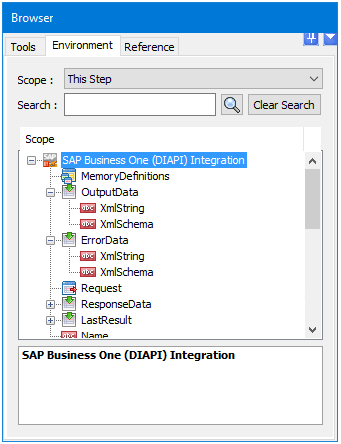
- InputData
The InputData document is only available if a recordset is the consumed Data Source. This contains the recordset data available for the task run.
- OutputData
- XmlString — This is the XML document produced by the tool, containing data returned from SAP Business One for all operations. Also included are the key fields for the mapped elements affected by the used operation — for example, if using an ADD operation, the key fields for the top-level object instances that are created are returned — and a SupplementaryReference field for task auditing purposes.
The mapped fields in the Mapping tab define the structure of this XML document. - XmlSchema — This contains the output schema in XSD format.
- ErrorData
- XmlString — This contains any error data reported by SAP Business One
- XmlSchema — This contains the output schema in XSD format.
The OutputData object contains two sub-objects:
The ErrorData object also contains two sub-objects:
<Error> — All errors are created as an <Error> node, with the following sub-nodes: <Object /> — The name of the requested object
<CODE /> — The error code returned by SAP Business One
<MESSAGE /> — The corresponding error message
<EXTENDEDINFO /> — A string containing additional information about the error
<INPUTDATA /> — The header input data (excluding child nodes) mapped for the object, plus all data contained in SupplementaryReference </Error>
- Request
This object exposes the mapped object’s fields for use in Memory definitions.
- ResponseData
This property is only for use when using a first generation tool.
- LastResult
This property is only for use when using a first generation tool.
- Step Properties
Standard step properties are also available allowing you to use statistical data of the SAP Business One
(DIAPI) Integration step.
Where Can the XML Output be Used?
The incoming XML is translated into the XML format for the object and operation selected in the configuration. The data for the linked fields is brought across into the output XML — only those fields that are linked are brought across. The XML is passed to the Connector, which then:
- Processes the data
- Performs the operation requested
- Recieves an XML document containing the response
Both the OutputData and ErrorData documents can be directly used by succeeding task steps that can consume XML data, as part of an application integration or synchronisation process. To use the documents in a non-XML consuming tool, use a Convert XML to Recordset step first to create a recordset copy of the XML data.
The XML documents are also available as consumable objects from the BPA Platform Browser (XmlString). When used in a task step, such as Format as Text or Save File, this exposes the actual XML string.
Error Handling
Errors are written to the BPA Platform Event Log (Tasks toolbar > Event Log) handled in the Options tab of the tool.
You define how errors are handled in the Options tab of the tool.
Reasons for the errors could include:
- Web service connection errors
- User privilege errors
- Errors from the API
- Warnings and messages from the API
Global Configuration
The global configuration for this tool is used to create connections to a SAP Business One company database.
You open this interface from the resources tree — expand System > Tools > Data Connectors and double-click SAP Business One (DIAPI) Integration in the items list.
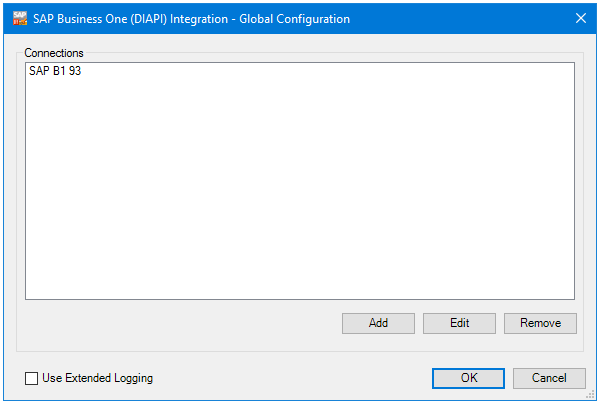
When a connection is made, the available objects and operations are retrieved.
Before you can use the SAP Business One (DIAPI) Integration tool in a task step, you must create the connection to SAP Business One first. Click Add.
Using Extended Logging
Enabling this option exposes the XML parsed between the SAP Business One (DIAPI) Integration tool and SAP Business One.
Without extended logging, the Event Log only contains start and end of transaction messages, plus any error messages encountered at runtime.
You can view the extended log in the BPA Platform Event Log (Tasks toolbar > Event Log)
About the Connection Tab
The Connection tab requires you to specify where the Integration Agent has been installed so communication can be established with SAP Business One.
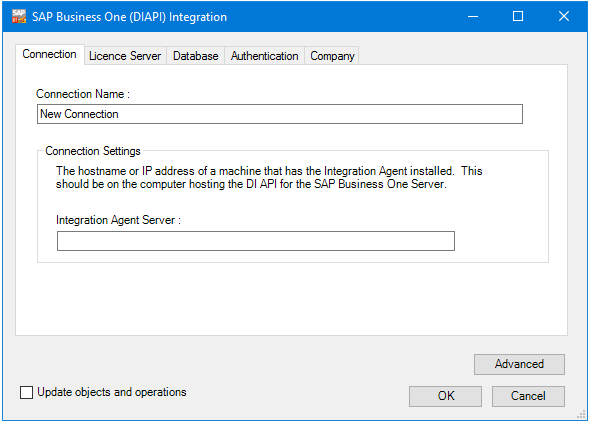
Enter a meaningful Connection Name for this Agent connection; this is the name displayed when adding task steps for SAP Business One.
Specify the Integration Agent Server name — as hostname, IP address, or URL. This should be the machine also hosting the DI API for SAP Business One.
By default, the connection to the Agent is over HTTP on TCP port 4205. Use the Advanced button to either Set a Custom Port Number if 4205 is already in use in your network, or to Use HTTPS to communicate to the Agent. This feature is particularly important if your SAP Business One instance is behind a firewall and makes use of Network Address Translation (NAT) — in this scenario, add the exposed port number here instead of the SAP instance port number.
About the Licence Server Tab
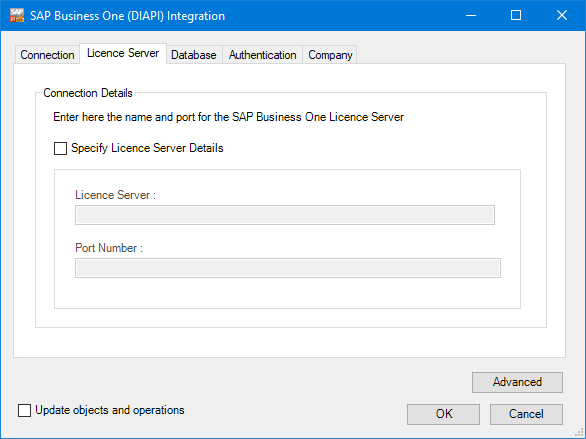
If connecting to SAP Business One v9.3 or earlier, select Specify Licence Server Details and enter the following for the SAP Business One License Manager Server; the License Manager Server must be the one managing the SAP Business One user account assigned to this Agent.
- Licence Server — Hostname, IP address, or URL
- Port Number
About the Database Tab
The Database tab requires the location of your SAP Business One company databases along with the credentials of an account with access to the database specified.
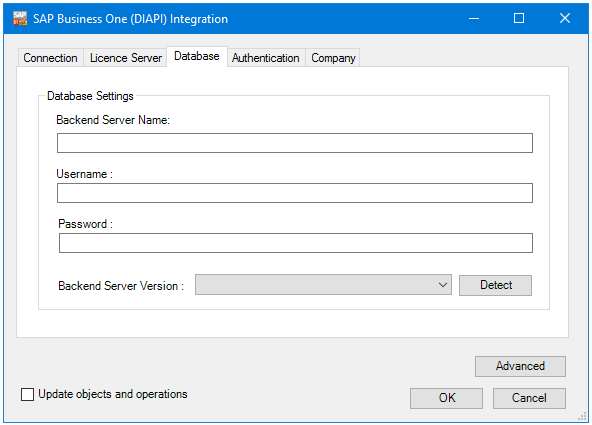
Enter the Backend Server Name for the SAP Business One database instance; for SAP HANA databases, this is the name you have registered this server with in the SAP Landscape Directory (SLD). This field is case-sensitive and must match the name exactly. Use the following formats:
- For SQL Server connections, all SAP Business One versions —
<hostname_or_URL>Use of the IP address for SQL Server connections is not supported by SAP Business One - For HANA v9.3 or earlier —
<hostname_or_IP_address>:<port> For example,SAP93-1:30015 - For HANA v10.0 or higher — <hostname_or_IP_address_or_URL>:<port> For example,
SAP10-1:30015 - For HANA v10.0 or higher, with multi-tenancy —
<tenant>@<hostname_or_IP_address_or_ URL>:<port>.
For example,HDB@SAP10-1:30013
Provide the credentials for the above database, in the form of the administrator’s Username and Password. This user must have read and write access to the relevant tenant’s company database.
It is recommended you use the Detect button to accurately detect the Backend Server Version, rather than selecting from the drop-down. This is used to validate the supplied information, and to detect the available SAP Business One company databases.
About the Authentication Tab
The Authentication tab requires the credentials of a SAP Business One user account used to access the database specified in the Database tab.
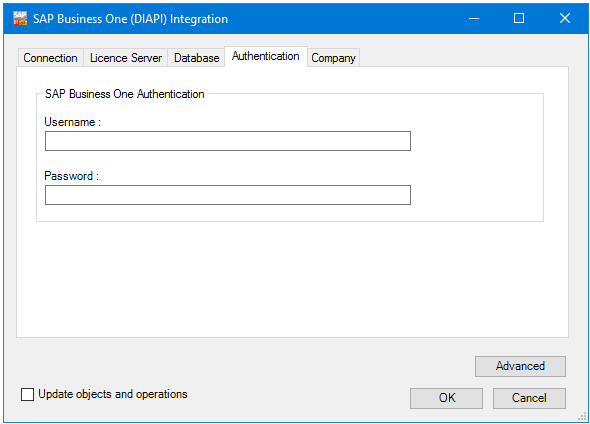
Enter the Username and Password for BPA Platform to use when accessing the SAP Business One company database.
About the Company Tab
Once the database location and authentication has been provided the Company tab will provide a list of all available SAP Business One company databases.
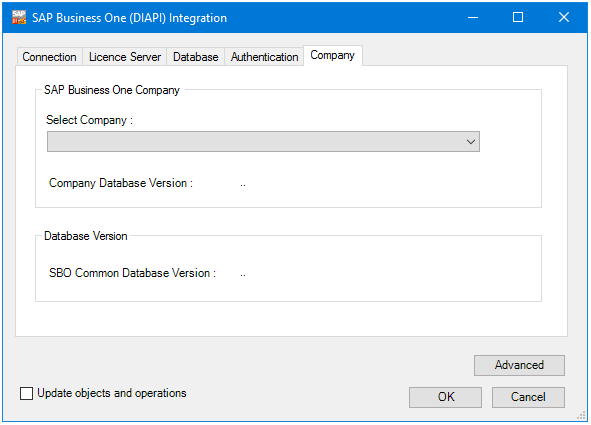
Using the Select Company drop-down list, you select the company (database) to use as the data source.
Update Objects and Operations
Enabling Update Objects and Operations allows the SAP Business One schema in BPA Platform to be refreshed every time an update is made in SAP Business One itself.
Should you also upgrade SAP Business One to a newer, compatible version, all related schemas within BPA Platform must be refreshed.
The schemas are refreshed when this selection and change has been saved. You must repeat this for each existing connection you have defined.
Step Configuration
When creating new tasks, the SAP Business One (DIAPI) Integration tool is located under Data Connectors of the Task Browser.
To add a new SAP Business One (DIAPI) Integration step to an existing task, do the following: From the relevant task, either:
- Click and drag the SAP Business One (DIAPI) Integration icon from the Task Browser to the task Design area.
- From the task’s Design tab, right-click on empty space and select New > Data Connectors > SAP Business One (DIAPI) Integration.
For a detailed description of how to create new tasks, refer to the product help.
About the General Tab
Use the General tab to choose the BPA Platform data source to be mapped to the SAP Business One objects. You can map data source objects from either an XML or recordset source.
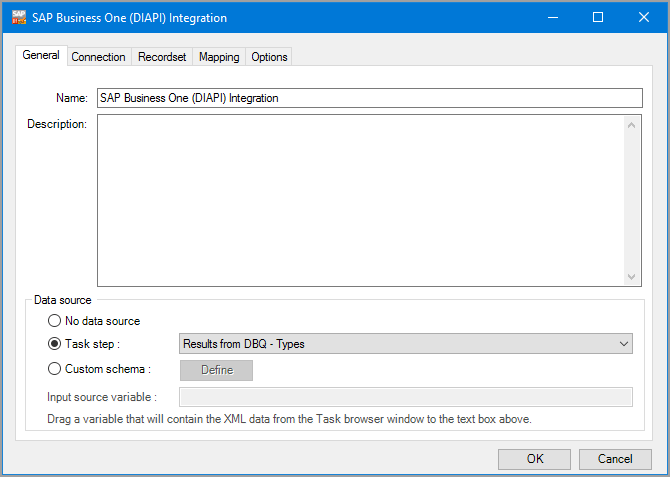
Provide a meaningful Name and Description for this step.
Data source can either be:
- No data source — If you don’t make use of a dedicated XML or recordset input source, select this option to use BPA Platform variables in place of the XML or recordset objects’ fields.
For example, you can extract various bits of information from an email and store them in BPA Platform variables. The variables are mapped to SAP Business One operational objects and fields to store in the database for later use. - Task step — The data source can be set to an available BPA Platform XML or recordset data source.
Only those steps that are capable of natively exposing an XML document or recordset at runtime are listed. This may be another SAP Business One (DIAPI) Integration step, or a tool such as Retrieve Text Message or Database Query (ODBC). - Custom schema — If using a recordset input data source, this option does not apply. An XML schema defines the structure of the parsed XML: what tags are present, and the nesting of the tags. You Define the schema of the XML that is used as the input data source for this step. The SAP Business One (DIAPI) Integration tool uses the industry standard XSD format. Any XML processed by this step must conform to this schema else an error will be reported.
If the XSD schema is available, either import it into the Custom Schema Configuration (use the Import XSD/XML File button), or copy and paste it into the configuration box.
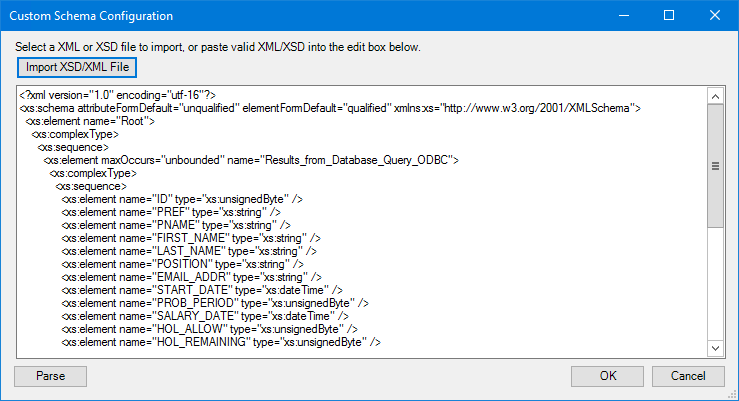
If the XSD schema is not available, you can import an example of the runtime XML (Import XSD/XML File), or copy and paste it into the configuration box. Use the Parse button to create the schema.
- Input source variable — If using a recordset input data source, this option does not apply. As well as defining the schema, specify the BPA Platform variable that contains the XML data at runtime.
About the Connection Tab
You specify the SAP Business One Connection this step must use.
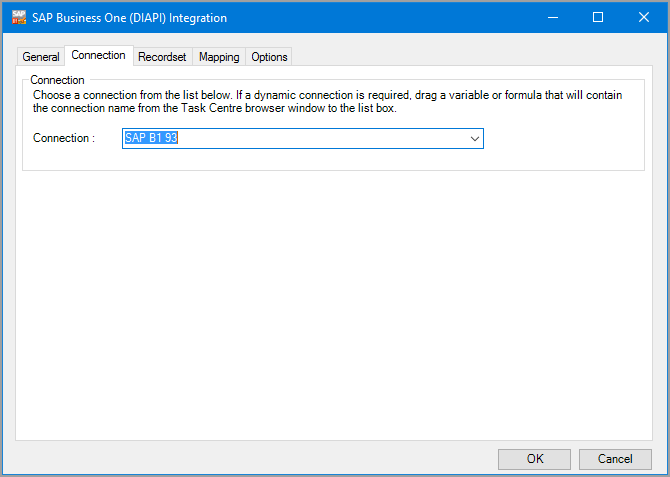
All connections created in the global configuration window are presented here.
Alternatively, you can use a BPA Platform variable or formula to create a dynamic connection, where the connection used is determined by runtime circumstances. At runtime, the contents of the variable must match the name of one of the Global Configuration connections — this is case-sensitive.
About the Recordset Tab
The Recordset tab is only available when a recordset is chosen as the Data Source in the General tab . SAP Business One only accepts XML from the SAP Business One (DIAPI) Integration tool, therefore you must use this tab to create the XML structure expected by the Mapping tab based on the parent and child relationships of an SAP Business One object.
An additional feature is that you can create an XML structure to enable looping on child elements of an object — for example, adding multiple addresses and contact details to a single business partner. For such a case, you would create the structure with a parent Key element which determine when a new header is found.
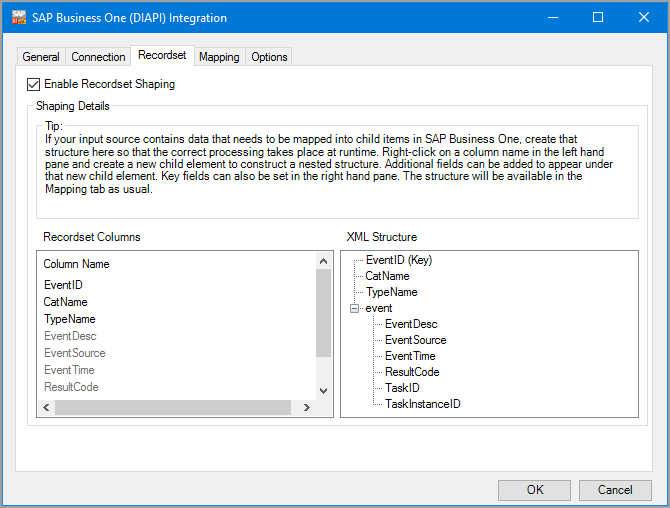
The Recordset Columns pane displays the recordset columns as a flat list; the XML Structure pane displays the XML as you build it.
Select Enable Recordset Shaping to map recordset data to an XML structure. However, if your recordset data is of a simple structure, that is the recordset columns map to a flat XML structure, skip directly to the Mapping tab.
The SAP Business One (DIAPI) Integration tool creates a basic XML structure based on the recordset data source. To set an XML element as the key, right-click on the XML element (right-hand pane) and select Set as Key.
To create a new child element, right-click on the required recordset column name and select Add new child element.
Provide a Name for the child element. This has a maximum of 64 characters and uses XML-supported characters only. The new child element appears in the XML Structure pane with the chosen recordset column as a field.
To add a recordset column to the new child node, right-click on the relevant column name and select Add to. Repeat until the child element has been built.
To remove a field from a child element, right-click on the field in the XML Structure pane and select Remove. To remove a child element in its entirety, you must remove each field first. Removing the final field removes the child element.
About the Mapping Tab
The Mapping tab is used to define links between the incoming XML or recordset data source, and the outgoing data that is to be sent to SAP Business One. Variables can also be included as an additional source for passing data across.
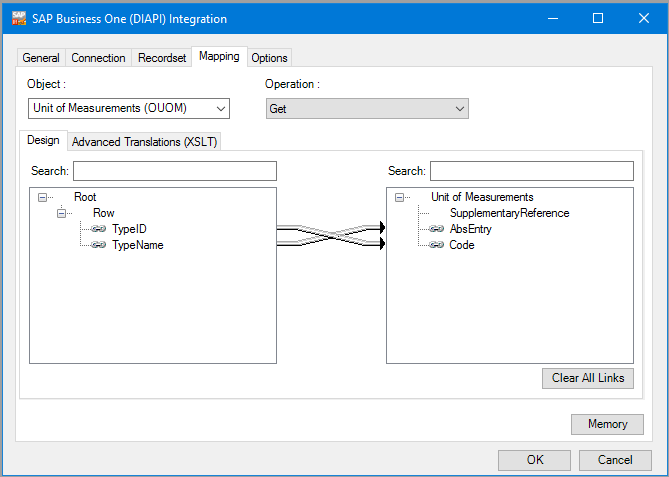
The Object drop-down shows the SAP Business One objects. If exposed, user-defined fields, objects, and tables are also made available for selection here. The Operations drop-down shows the operations available for the selected Object.
Further down, the left-hand XML tree structure shows those data source fields available for mapping . The right-hand XML tree structure displays those input fields for the selected Object and Operation.
Creating Mappings
Create links by dragging and dropping a data source field (left) onto its corresponding SAP Business One (DIAPI) Integration input field (right). Only linked fields are used in the output XML.
BPA Platform formulas and variables can be included in the source data even when using a Task step or Custom schema — drag them from the BPA Platform Browser to the data source’s XML; these can then be linked to the relevant input fields. BPA Platform recordsets must first be converted to XML using either the Convert Recordset to XML or Transform Data tool before they can be used here.
Each operation has an additional field, SupplementaryReference, which allows for traceability when transferring data from one place to another. When mapped, the data resides locally at runtime. It is added to the output, and creates a record for reference purposes only — you can choose to map any field to SupplementaryReference to assist with checking where the data originated from or at what time the data transfer occurred, for example.
The SAP Business One (DIAPI) Integration tool uses eXtensible Stylesheet Language Transformations (XSLT) to translate the received XML. The Advanced Translations (XSLT) tab shows the XSLT generated for the links created for the object and operation. Use Enable Free Type Mode to directly edit the XSLT — this is particularly useful when translating a non-standard requirement.
Refreshing the SAP Business One (DIAPI) Integration’s Schema
If new fields, objects, and operations have been added to your SAP Business One company database after this task step was originally created, use Schema Refresh to make the latest API metadata available for use.
About User-Defined Objects
The SAP Business One (DIAPI) Integration tool supports the use of user-defined objects, whether created manually or imported from an external source into SAP. User-defined objects are exposed in the tool via the Object drop-down. They appear at the top of the list and are prefixed with a # symbol.
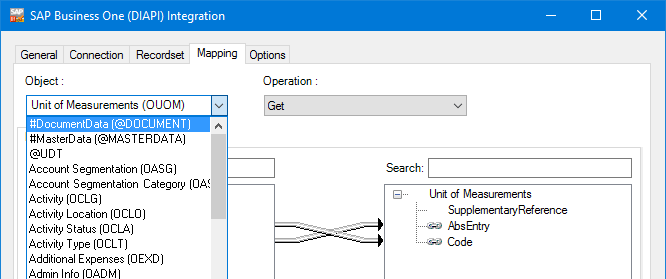
Each user-defined object contains the mandatory operations Add and Update, along with any other operation defined during its creation.
Any user-defined object that has the Log option enabled in SAP Business One has access to history data. Using the SAP Business One (DIAPI) Integration tool, you can retrieve the previous value of a field after an update occurs by mapping a variable to it.
About User-Defined Tables
The SAP Business One (DIAPI) Integration tool supports the use of user-defined tables. A user-defined table is exposed in the tool via the Object drop-down. It appears at the top of the list and is prefixed with an @ symbol.
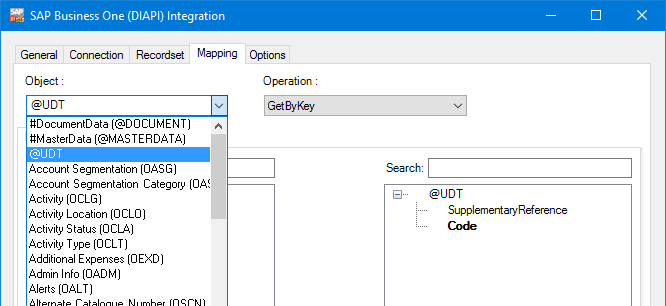
Selecting the table followed by an operation presents your custom fields within the right-hand pane.
About User-Defined Fields
The SAP Business One (DIAPI) Integration tool supports the use of user-defined fields. A user-defined field that has been inserted into an existing object or sub-object is exposed in the XML structure of the right-hand pane, after the object has been selected. The field is prefixed with U_.
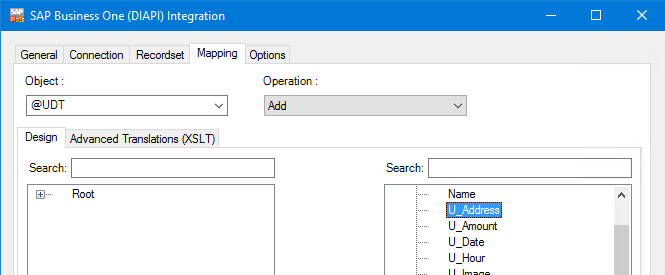
About Using Memory
The Memory button allows one of the following memory types to be added to the step:
- OLEDB Memory
- ODBC Memory
- Call Stored Procedure Memory
- Internal Memory
Memory definitions can be used to specify data to be memorised when processed by a SAP Business One (DIAPI) Integration step at runtime. The captured data is then passed into the relevant destination location, whether that is a defined SQL Server database table or an internal repository within BPA Platform.
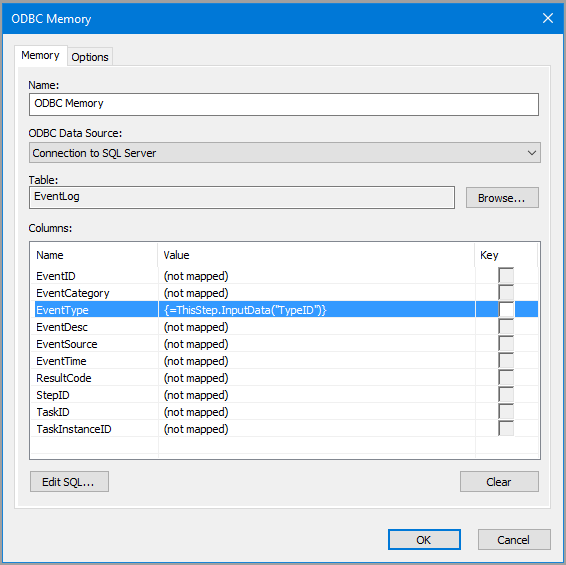
With the SAP Business One (DIAPI) Integration tool it is possible to memorise inputs to the tool step, as well as the following outputs relating to the response from the call to SAP Business One:
| Output | Description |
|---|---|
ObjectCode | Not returned on failure Not returned for Search or GetList operations |
RequestFailed | Returns 0 on success, Returns -1 on failure |
ErrorMessage | Blank on success |
ErrorMessageExtended | Blank on success |
ErrorCode | Blank on success |
Use of the Memory option in the SAP Business One (DIAPI) Integration tool alters the processing method of the step at runtime. By default, the SAP Business One (DIAPI) Integration step submits its data to SAP Business One in a single XML request; when the Memory option is defined, each record is processed on a row by row basis.
If inputs alone are used in Memory, then the Memory processing starts first, and if successful, then the request to SAP Business One is sent.
Supported Objects
The objects and operations currently available are shown in the table below, where:
| Key for Standard Operations | |
|---|---|
A — Add | GK — GetByKey |
Cl — Close | GL — GetList |
Ca — Cancel | S — Search |
DR — Delete / Remove | U — Update |
G — Get | |
| SAP B1 Objects | Standard Operations | Comments | ||||||||
|---|---|---|---|---|---|---|---|---|---|---|
| G | GK | GL | A | U | DR | S | CA | CI | ||
| Account Segmentation (OASG) | US SAP only | |||||||||
| Account Segmentation Category (OASC) | US SAP only | |||||||||
| Activity (OCLG) | ||||||||||
| Activity Location (OCLO) | ||||||||||
| Activity Status (OCLA) | ||||||||||
| Activity Type (OCLT) | ||||||||||
| Additional Expenses (OEXD) | ||||||||||
| Admin Info (OADM) | Supported operations: GetAdminInfo, UpdateAdminInfo | |||||||||
| Alerts (OALT) | Supported operations: GetAlertManagment, UpdateAlertManagment, AddAlertManagment, GetAlertManagmentList | |||||||||
| Alternative Catalogue Number (OSCN) | ||||||||||
| Alternative Items (OALI) | Additional supported operations: AddItem, DeleteItem, GetItem | |||||||||
| SAP B1 Objects | Standard Operations | Comments | ||||||||
|---|---|---|---|---|---|---|---|---|---|---|
| G | GK | GL | A | U | DR | S | CA | CI | ||
| Asset Documents (OACQ) | ||||||||||
| Attachments (OATC) | ||||||||||
| Bank Code (ODSC) | ||||||||||
| Bank Pages (OBNK) | ||||||||||
| Bank Statements (OBNH) | Additional supported operations: AddBankStatement, DeleteBankStatement, GetBankStatement, GetBankStatementList | |||||||||
| Bar Codes (OBCD) | Not supported in 8.82 | |||||||||
| Batch Number Details (OBTN) | ||||||||||
| Bill of Exchange Transaction (OBOT) | ||||||||||
| Bill of Materials (OITT) | ||||||||||
| Bin Location Attributes (OBAT) | Not supported in 8.82 | |||||||||
| Bin Location Fields (OBFC) | Not supported in 8.82 | |||||||||
| Bin Locations (OBIN) | Not supported in 8.82 | |||||||||
| SAP B1 Objects | Standard Operations | Comments | ||||||||
|---|---|---|---|---|---|---|---|---|---|---|
| G | GK | GL | A | U | DR | S | CA | CI | ||
| Blanket Agreement (OOAT) | Additional supported operations: AddBlanketAgreement, GetBlanketAgreement, GetBlanketAgreementList | |||||||||
| BP Priority (OBPP) | ||||||||||
| Budget (OBGT) | ||||||||||
| Budget Distribution (OBGD) | ||||||||||
| Budget Scenario (OBGS) | ||||||||||
| Business Partner (OCRD) | ||||||||||
| Business Partner Group (OCRG) | ||||||||||
| Campaigns (OCPN) | ||||||||||
| Chart of Account (OACT) | ||||||||||
| Checks for Payment (OCHO) | ||||||||||
| Choose From List (OCHF) | ||||||||||
| Closing Date Procedure (OCDP) | ||||||||||
| SAP B1 Objects | Standard Operations | Comments | ||||||||
|---|---|---|---|---|---|---|---|---|---|---|
| G | GK | GL | A | U | DR | S | CA | CI | ||
| Commission Group (OCOG) | ||||||||||
| Contract Template (OCTT) | ||||||||||
| Correction Invoice (OCSI) | ||||||||||
| Correction Invoice Reversal (OCSV) | ||||||||||
| Cost Centre (OPRC) | Supported operations: AddProfitCenter, UpdateProfitCenter, DeleteProfitCenter, GetProfitCenter, GetProfitCenterList | |||||||||
| Credit Card (OCRC) | ||||||||||
| Credit Card Payment (OCDT) | ||||||||||
| Credit Note (ORIN) | ||||||||||
| Credit Payment Method (OCRP) | ||||||||||
| Currencies (OCRN) | ||||||||||
| Currency Exchange Rate | SAP 9.1 only | |||||||||
| Customer Equipment Card (OINS) | ||||||||||
| SAP B1 Objects | Standard Operations | Comments | ||||||||
|---|---|---|---|---|---|---|---|---|---|---|
| G | GK | GL | A | U | DR | S | CA | CI | ||
| Customs Group (OARG) | ||||||||||
| Deduction Tax Group (ODDG) | ||||||||||
| Deduction Tax Hierarchy (ODDT) | ||||||||||
| Delivery Note (ODLN) | ||||||||||
| Deposits Service | Supported operations: GetDeposit, AddDeposit, UpdateDeposit, CancelDeposit, GetDepositList, CancelCheckRow, CancelDepositbyCurrentSystemDate, CancelCheckRowbyCurrentSystemDate | |||||||||
| Draft Document (ODRF) | ||||||||||
| Dunning Letter (ODUN) | ||||||||||
| Employee Info (OHEM) | ||||||||||
| Factoring Indicator (OIDC) | ||||||||||
| Fiscal Registry ID (OCNA) | ||||||||||
| Form 1099 (OTNN) | ||||||||||
| SAP B1 Objects | Standard Operations | Comments | ||||||||
|---|---|---|---|---|---|---|---|---|---|---|
| G | GK | GL | A | U | DR | S | CA | CI | ||
| Goods Issue (OIGE) | ||||||||||
| Goods Receipt (OIGN) | ||||||||||
| House Bank Account (DSC1) | ||||||||||
| Incoming Payment (ORCT) | ||||||||||
| Industry (OOND) | ||||||||||
| Inventory Countings (OINC) | ||||||||||
| Inventory Cycle (OCYC) | ||||||||||
| Inventory Postings (OIQR) | SAP 9.1 supports only GetList | |||||||||
| Inventory Transfer Request (OWTQ) | ||||||||||
| Invoice (OINV) | ||||||||||
| Item (OITM) | ||||||||||
| Item Group (OITB) | ||||||||||
| Journal Entry (OJDT) | ||||||||||
| Journal Voucher (OBTD) | ||||||||||
| SAP B1 Objects | Standard Operations | Comments | ||||||||
|---|---|---|---|---|---|---|---|---|---|---|
| G | GK | GL | A | U | DR | S | CA | CI | ||
| Knowledge Base Solution (OSLT) | ||||||||||
| Landed Costs (OIPF) | Supported operations are: AddLandedCost, UpdateLandedCost, GetLandedCost, GetLandedCostList, CloseLandedCost, CancelLandedCost, SAP 9.1 supports only GetList | |||||||||
| Length Unit (OLGT) | ||||||||||
| Loaded Expenses (OALC) | ||||||||||
| Manufacturer (OMRC) | ||||||||||
| Material Revaluation (OMRV) | SAP 9.1 supports only GetList | |||||||||
| Material Revaluation FIFO | Single supported operation: GetMaterialRevaluationFIFO | |||||||||
| Messages | Supported operations: GetInbox, GetOutbox, GetSentMessages, GetMessage, SendMessage | |||||||||
| Multi-Language Translation (OMLT) | ||||||||||
| SAP B1 Objects | Standard Operations | Comments | ||||||||
|---|---|---|---|---|---|---|---|---|---|---|
| G | GK | GL | A | U | DR | S | CA | CI | ||
| Outgoing Payments (OVPM) | ||||||||||
| Packages Type (OPKG) | ||||||||||
| Partners Setup (OPRT) | ||||||||||
| Payment Draft (OPDF) | ||||||||||
| Payment Methods for Payment Wizard (OPYM) | ||||||||||
| Payment Results (OPEX) | ||||||||||
| Payment Term (OCTG) | ||||||||||
| Pick List (OPKL) | ||||||||||
| Predefined Text (OPDT) | Additional supported operations: AddPredefinedText, DeletePredefinedText, GetPredefinedText, GetPredefinedTextList | |||||||||
| Price List (OPLN) | ||||||||||
| Production Order (OWOR) | ||||||||||
| Project (OPRJ) | ||||||||||
| Project Management (OPMG) | Supported operations: GetProject, AddProject, UpdateProject, CancelProject, GetSubProjectList, GetSubProject, AddSubProject, UpdateSubProject, DeleteSubProject | |||||||||
| Project Management Configuration | Supported operations: GetSubprojectTypes, AddSubprojectTypes, UpdateSubProjectTypes, DeleteSubProjectTypes, GetStageTypes, AddStageTypes, UpdateStageTypes, DeleteStageTypes, GetAreas, AddAreas, UpdateAreas, DeleteAreas, GetPriorities, AddPriorities, UpdatePriorities, DeletePriorities, GetActivities, AddActivities, UpdateActivities, DeleteActivities, GetTasks, AddTasks, UpdateTasks, DeleteTasks | |||||||||
| Project Management Time Sheet (OTSH) | Supported operations: AddTimesheet, UpdateTimesheet, DeleteTimesheet, GetTimesheet | |||||||||
| SAP B1 Objects | Standard Operations | Comments | ||||||||
|---|---|---|---|---|---|---|---|---|---|---|
| G | GK | GL | A | U | DR | S | CA | CI | ||
| Purchase Correction Invoice (OCPI) | Supported operations: AddTimesheet, UpdateTimesheet, DeleteTimesheet, GetTimesheet | |||||||||
| Purchase Correction Invoice Reversal (OCPV) | ||||||||||
| Purchase Credit Notes (ORPC) | ||||||||||
| Purchase Delivery Notes (OPDN) | ||||||||||
| Purchase Down Payment (ODPO) | ||||||||||
| Purchase Invoice (OPCH) | ||||||||||
| Purchase Order (OPOR) | ||||||||||
| Purchase Quotations (OPQT) | ||||||||||
| Purchase Request (OPRQ) | ||||||||||
| Purchase Return (ORPD) | ||||||||||
| SAP B1 Objects | Standard Operations | Comments | ||||||||
|---|---|---|---|---|---|---|---|---|---|---|
| G | GK | GL | A | U | DR | S | CA | CI | ||
| Russian SAP only | ||||||||||
| Query Category (OQCN) | ||||||||||
| Queue (OQUE) | ||||||||||
| Quotation (OQUT) | ||||||||||
| Relationship (OORL) | ||||||||||
| Return (ORDN) | ||||||||||
| Sales Down Payment (ODPI) | ||||||||||
| Sales Forecast (OFCT) | ||||||||||
| Sales Opportunity (OOPR) | ||||||||||
| Sales Order (ORDR) | ||||||||||
| Sales Person (OSLP) | ||||||||||
| Sales Stage (OOST) | ||||||||||
| Sales Tax Authorities Type (OSTT) | ||||||||||
| Sales Tax Authority (OSTA) | ||||||||||
| SAP B1 Objects | Standard Operations | Comments | ||||||||
|---|---|---|---|---|---|---|---|---|---|---|
| G | GK | GL | A | U | DR | S | CA | CI | ||
| Sales Tax Code (OSTC) | ||||||||||
| Russian SAP only | ||||||||||
| Serial Numbers (OSRN) | ||||||||||
| Service Call (OSCL) | ||||||||||
| Service Contract (OCTR) | ||||||||||
| Shipping Type (OSHP) | ||||||||||
| Special Price (OSPP) | ||||||||||
| Stock Transfer (OWTR) | ||||||||||
| Stock Transfer Draft (ODRF) | ||||||||||
| Target Groups (OTGG) | ||||||||||
| Team (OHTM) | ||||||||||
| Territory (OTER) | ||||||||||
| Unit of Measurement Groups (OUGP) | Not supported in 8.82 | |||||||||
| Unit of Measurements (OUOM) | Not supported in 8.82 | |||||||||
| SAP B1 Objects | Standard Operations | Comments | ||||||||
|---|---|---|---|---|---|---|---|---|---|---|
| G | GK | GL | A | U | DR | S | CA | CI | ||
| User Tables (OUTB) | Not supported in 8.82 or 9.0 | |||||||||
| User (OUSR) | ||||||||||
| User Default (OUDG) | ||||||||||
| User Fields (CUFD) | ||||||||||
| User Query (OUQR) | ||||||||||
| VAT Groups (OVTG) | ||||||||||
| Warehouse (OWHS) | ||||||||||
| Warehouse Location (OLCT) | ||||||||||
| Warehouse Sublevel Codes (OWHS) | Not supported in 8.82 | |||||||||
| Weight Measure (OWGT) | ||||||||||
| Withholding Tax Codes (OWHT) | ||||||||||
About the Options Tab
The Options tab allows you to define how errors in this step are handled at task runtime.
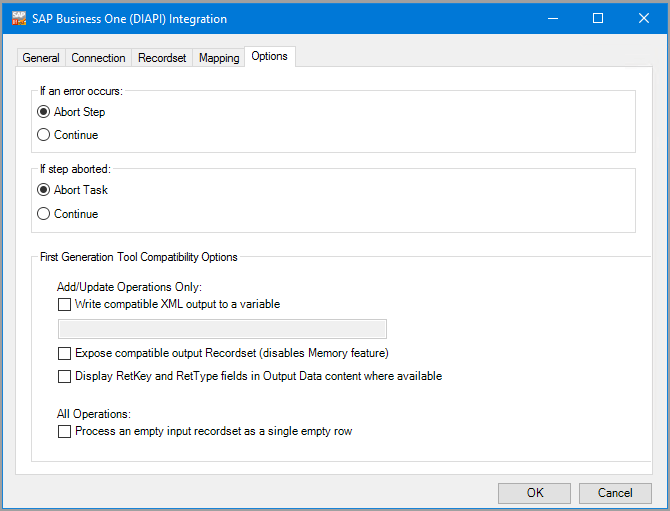
If an error occurs, you can decide whether the step should Continue processing, or terminate the step immediately (Abort Step).
If the step is aborted, you can choose to Continue processing onto the next step in the task, or terminate the whole task immediately (Abort Task). By allowing the task to Continue, you can use the error XML received back in a Save File step for investigation purposes, for example.
First Generation Tool Compatibility Options
The configuration under the First Generation Tool Compatibility Options panel is only required when converting from older generation tools. For more information, refer to your account manager or business partner.
The parameters are grouped according to SAP Business One operations:
- Add / Update Operations Only
- Write compatible XML output to a variable — Select this option if you want to write the output from an
ADDorUPDATEoperation to a task variable. This variable cannot be a Datafile or Password type (for more information, refer to the BPA Platform product help). - Expose compatible output Recordset (disables Memory feature) — Typically, output from the SAP Business One (DIAPI) Integration tool is in XML form. Selecting this option also exposes a BPA Platform recordset version for use in later task steps. This is only for
ADDorUPDATEoperations. Note that the Memory feature does not work if outputting to recordset as well (for more information, refer to the BPA Platform product help). - Display RetKey and RetType fields in Output Data content where available — Select to include the Return Key and Return Type fields (note that these may not be available for every object) in the output XML for ADD and UPDATE operations only.
- All Operations
- Process an empty input recordset as a single empty row — If the input data source doesn’t return a recordset, for example, a Database Query (ODBC) step returning no rows, you can choose whether to send a single empty row.
About the SAP Business One (SL) Integration Tool
The SAP Business One (SL) Integration tool is used to communicate with a SAP Business One server over the Service Layer. When used in a task, the step exposes the objects and fields of a single company database allowing operations such as ADD, UPDATE, DELETE, SEARCH, and in some circumstances, CANCEL, or CLOSE.
The SAP Business One (SL) Integration tool can consume an XML or recordset data source and output XML for subsequent task steps to consume. Before you use the SAP Business One (SL) Integration tool in a task, a global connection to SAP Business One must be established.
About the SAP Business One (SL) Integration Agent
In order to communicate with the SAP Business One Service Layer, you must install the SAP Business One (SL) Integration Agent. This acts as a “go-between” between the SAP Business One server and the SAP Business One (SL) Integration tool, and runs as a service on the installed computer. Note that it is not necessary to install the Agent on the BPA Platform server.
Working with Other Tools
The SAP Business One (SL) Integration tool can directly interact with the following tools:
Consuming from Other Tools
The SAP Business One (SL) Integration tool can consume output from the following tools:
| Icon | Tool Name | Tool Category |
|---|---|---|
| Call Stored Procedure (OLEDB) | Input, Data Connectors, Output, and Execute | |
| Database Query (ODBC) | Input and Data Connectors | |
| Database Query (OLEDB) | Input and Data Connectors | |
| Database Query (HANA) | Input and Data Connectors | |
| Import Flat File | Input | |
| Import XML Document | Input | |
| Retrieve Text Message | Input | |
| Convert Recordset to XML | Format | |
| Convert XML to Recordset | Format | |
| SAP Business One (DIAPI) Integration | Data Connectors | |
| SAP Business One (SL) Integration | Data Connectors |
Objects Consumed
The SAP Business One (SL) Integration tool consumes the following objects exposed by other steps:
- XML — XML data from any BPA Platform tool capable of exposing such data (see above)
- Recordset — Tabular data from any BPA Platform tool capable of exposing such data (see above)
Exposing to Other Tools
The following tools can directly consume output from the SAP Business One (SL) Integration tool:
| Icon | Tool Name | Tool Category |
|---|---|---|
| Retrieve Text Message | Input | |
| Convert XML to Recordset | Format | |
| Run Microsoft Reporting Services | Format | |
| Save File | Output | |
| Web Service Connector | Data Connectors | |
| SAP Business One (DIAPI) Integration | Data Connectors | |
| SAP Business One (SL) Integration | Data Connectors |
Objects Exposed
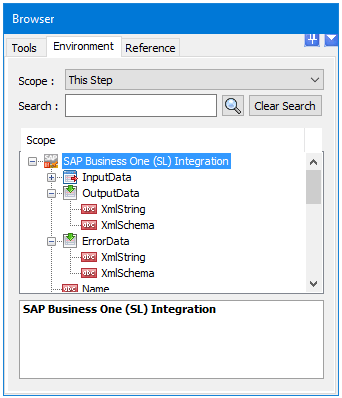
- InputData
- OutputData
The InputData document is only available if a recordset is the consumed Data Source. This contains the recordset data available for the task run.
The OutputData object contains two sub-objects:
- XmlString — This is the XML document produced by the tool, containing data returned from SAP Business One for all operations. Also included are the key fields for the mapped elements affected by the used operation — for example, if using an
ADDoperation, the key fields for the top-level object instances that are created are returned — and aSupplementaryReferencefield for task auditing purposes.
The mapped fields in the Mapping tab define the structure of this XML
document. - XmlSchema — This contains the output schema in XSD format.
- ErrorData
- XmlString — This contains any error data reported by SAP Business One
- XmlSchema — This contains the output schema in XSD format.
- Step Properties
The ErrorData object also contains two sub-objects:
<Error> — All errors are created as an <Error> node, with the following sub-nodes:
<Object /> — The name of the requested object
<CODE /> — The error code returned by SAP Business One
<MESSAGE /> — The corresponding error message
<EXTENDEDINFO /> — A string containing additional information about the error
<INPUTDATA /> — The header input data (excluding child nodes) mapped for the object, plus all data contained in SupplementaryReference
</Error>
Standard step properties are also available allowing you to use statistical data of the SAP Business One (SL) Integration step.
Where Can the XML Output be Used?
The incoming XML is translated into the XML format for the object and operation selected in the configuration. The data for the linked fields is brought across into the output XML — only those fields that are linked are brought across. The XML is passed to the Connector, which then:
- Processes the data
- Performs the operation requested
- Recieves an XML document containing the response
Both the OutputData and ErrorData documents can be directly used by succeeding task steps that can consume XML data, as part of an application integration or synchronisation process. To use the documents in a non-XML consuming tool, use a Convert XML to Recordset step first to create a recordset copy of the XML data.
The XML documents are also available as consumable objects from the BPA Platform Browser (XmlString). When used in a task step, such as Format as Text or Save File, this exposes the actual XML string.
Error Handling
Errors are written to the BPA Platform Event Log (Tasks toolbar > Event Log). You define how errors are handled in the Options tab of the tool.
Reasons for the errors could include:
- Web service connection errors
- User privilege errors
- Errors from the API
- Warnings and messages from the API
Global Configuration
The global configuration for this tool is used to create connections to a SAP Business One company database. You access the SAP Business One (SL) Integration – Global Configuration window by either:
You open this interface from the resources tree — expand System > Tools > Data Connectors and double-click SAP Business One (SL) Integration in the items list.
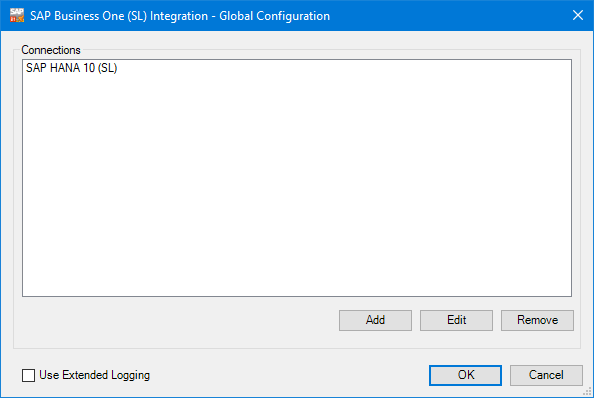
When a connection is made, the available objects and operations are retrieved.
Before you can use the SAP Business One (SL) Integration tool in a task step, you must create the connection to SAP
Business One first. Click Add.
Using Extended Logging
Enabling this option exposes the XML parsed between the SAP Business One (SL) Integration tool and SAP Business One.
Without extended logging, the Event Log only contains start and end of transaction messages, plus any error messages encountered at runtime.
You can view the extended log in the BPA Platform Event Log (Tasks toolbar > Event Log)
About the Agent Connection Tab
The Agent Connection tab requires you to specify where the Integration agent has been installed so communication can be established with SAP Business One.
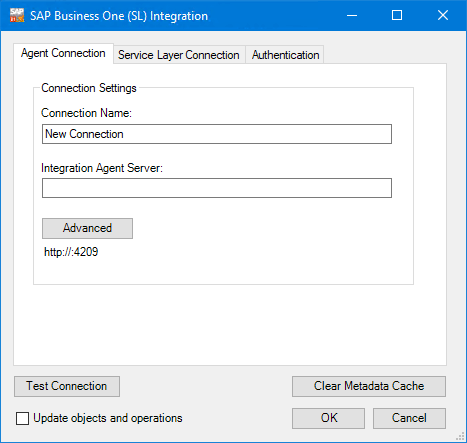
Enter a meaningful Connection Name for this agent connection; this is the name displayed when adding task steps for SAP Business One.
Specify the Integration Agent Server as hostname, IP address, or URL. Typically, this is the BPA Platform server but remote installations are also supported. Note that you cannot install the Agent into the same machine hosting the Service Layer for SAP HANA as this is a Linux machine.
By default, the connection to the Agent is over HTTP on TCP port 4209. Use the Advanced button to either Set a Custom Port Number if 4209 is already in use in your network, or to Use HTTPS to communicate to the Agent.
This feature is particularly important if your SAP Business One instance is behind a firewall and makes use of Network Address Translation (NAT) — in this scenario, add the exposed port number here instead of the SAP instance port number.
About the Service Layer Tab
The Service Layer tab requires the location of the SAP Service Layer.
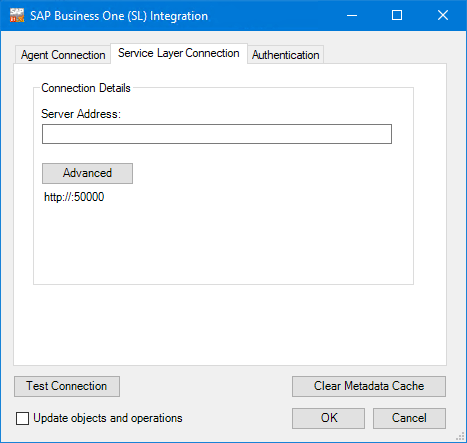
Specify Server Address as hostname, IP address, or URL.
By default, the connection is over HTTP on TCP port 50000. Use the Advanced button to either Set a Custom Port Number if 50000 is already in use in your network, or to Use HTTPS to communicate to the Agent. This feature is particularly important if your Service Layer machine is behind a firewall and makes use of Network Address Translation (NAT) — in this scenario, add the exposed port number here instead of the SAP instance port number.
About the Authentication Tab
The Authentication tab requires the credentials of a SAP Business One user account used to access the company database.
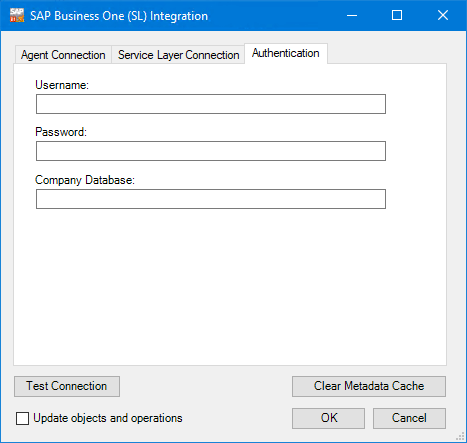
Enter the Username and Password for BPA Platform to use when accessing the SAP Business One company database.
Enter the Company Database this instance of the SAP Business One (SL) Integration tool interacts with. Note that this is case-sensitive.
Test Connection
Use Test Connection to ensure all entered details are correct and a connection to the various aspects of SAP Business One can be established.
Update Objects and Operations
Enabling Update Objects and Operations allows the SAP Business One schema in BPA Platform to be refreshed every time an update is made in SAP Business One itself.
Should you also upgrade SAP Business One to a newer, compatible version, all related schemas within BPA Platform must be refreshed.
The schemas are refreshed when this selection and change has been saved. You must repeat this for each existing connection you have defined.
Clear Metadata Cache
For each object mapped, the metadata is requested and downloaded from the SAP Business One Service Layer. This is cached locally to the SAP Business One (SL) Integration Agent in C:\Program Files (x86)\SAP Business One (SL) Integration Agent\MetadataCache (unless a custom folder was specified at installation time). This allows the SAP Business One (SL) Integration tool to quickly populate its Objects list and input fields when the step is opened, rather than pulling down from the Service Layer each time.
If user-defined fields (UDF), objects (UDO), or tables (UDT) are added to a mapped SAP Business One object, they won’t appear until the cache is reset (Clear Metadata Cache) even if you enable Update Object and Operations.
Step Configuration
When creating new tasks, the SAP Business One (SL) Integration tool is located under Data Connectors of the Task Browser.
To add a new SAP Business One (SL) Integration step to an existing task, do the following: From the relevant task, either:
- Click and drag the SAP Business One (SL) Integration icon from the Task Browser to the task Design area.
- From the task’s Design tab, right-click on empty space and select New > Data Connectors > SAP Business One (SL) Integration.
About the General Tab
Use the General tab to choose the BPA Platform data source to be mapped to the SAP Business One objects. You can map data source objects from either an XML or recordset source.

Provide a meaningful Name and Description for this step.
Data source can either be:
- No data source — If you don’t make use of a dedicated XML or recordset input source, select this option to use BPA Platform variables in place of the XML or recordset objects’ fields.
For example, you can extract various bits of information from an email and store them in BPA Platform variables. The variables are mapped to SAP Business One operational objects and fields to store in the database for later use. - Task step — The data source can be set to an available BPA Platform XML or recordset data source.
Only those steps that are capable of natively exposing an XML document or recordset at runtime are listed. This may be another SAP Business One (SL) Integration step, or a tool such as Retrieve Text Message or Database Query (ODBC). - Custom schema — If using a recordset input data source, this option does not apply. An XML schema defines the structure of the parsed XML: what tags are present, and the nesting of the tags. You Define the schema of the XML that is used as the input data source for this step. The SAP Business One (SL) Integration tool uses the industry standard XSD format. Any XML processed by this step must conform to this schema else an error will be reported.
If the XSD schema is available, either import it into the Custom Schema Configuration (use the Import XSD/XML File button), or copy and paste it into the configuration box.

If the XSD schema is not available, you can import an example of the runtime XML (Import XSD/XML File), or copy and paste it into the configuration box. Use the Parse button to create the schema.
- Input source variable — If using a recordset input data source, this option does not apply. As well as defining the schema, specify the BPA Platform variable that contains the XML data at runtime.
About the Connection Tab
You specify the SAP Business One Connection this step must use.
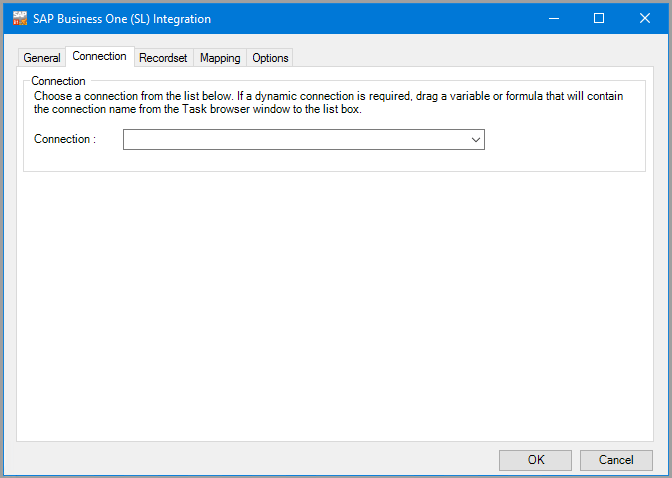
All connections created in the global configuration window are presented here.
Alternatively, you can use a BPA Platform variable or formula to create a dynamic connection, where the connection used is determined by runtime circumstances. At runtime, the contents of the variable must match the name of one of the Global Configuration connections — this is case-sensitive.
About the Recordset Tab
The Recordset tab is only available when a recordset is chosen as the Data Source in the General tab . SAP Business One only accepts XML from the SAP Business One (SL) Integration tool, therefore you must use this tab to create the XML structure expected by the Mapping tab based on the parent and child relationships of an SAP Business One object.
An additional feature is that you can create an XML structure to enable looping on child elements of an object — for example, adding multiple addresses and contact details to a single business partner. For such a case, you would create the structure with a parent Key element which determine when a new header is found.
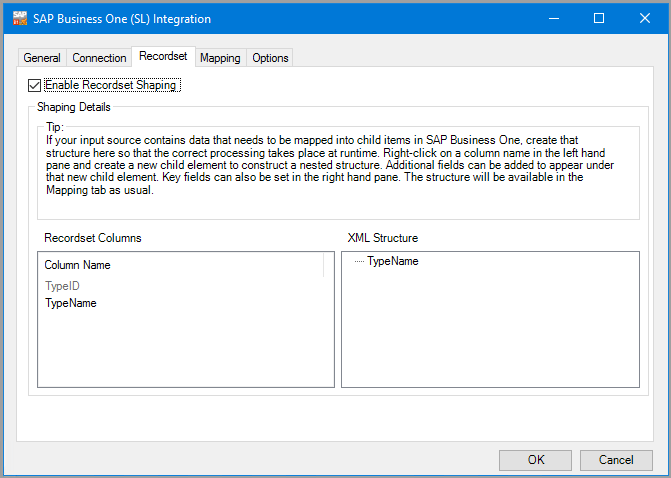
The Recordset Columns pane displays the recordset columns as a flat list; the XML Structure pane displays the XML as you build it.
Select Enable Recordset Shaping to map recordset data to an XML structure. However, if your recordset data is of a simple structure, that is the recordset columns map to a flat XML structure, skip directly to the Mapping tab.
The SAP Business One (SL) Integration tool creates a basic XML structure based on the recordset data source. To set an XML element as the key, right-click on the XML element (right-hand pane) and select Set as Key.
To create a new child element, right-click on the required recordset column name and select Add new child element.
Provide a Name for the child element. This has a maximum of 64 characters and uses XML-supported characters only. The new child element appears in the XML Structure pane with the chosen recordset column as a field.
To add a recordset column to the new child node, right-click on the relevant column name and select Add to. Repeat until the child element has been built.
To remove a field from a child element, right-click on the field in the XML Structure pane and select Remove. To remove a child element in its entirety, you must remove each field first. Removing the final field removes the child element.
About the Mapping Tab
The Mapping tab is used to define links between the incoming XML or recordset data source, and the outgoing data that is to be sent to SAP Business One. Variables can also be included as an additional source for passing data across.
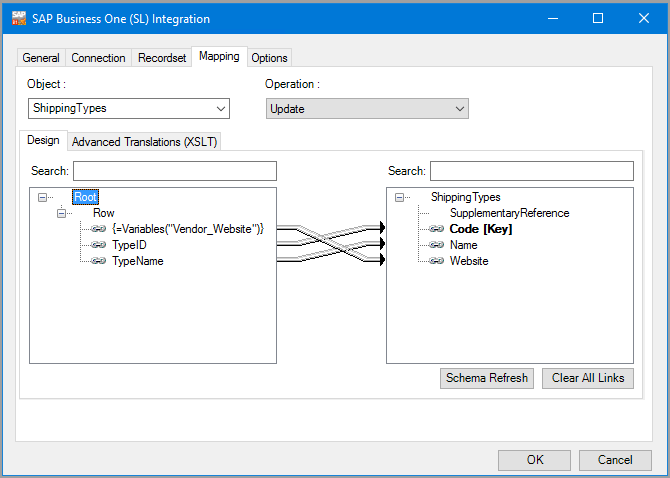
The Object drop-down shows the SAP Business One objects. If exposed, user-defined fields and objects are also made available for selection here. The Operations drop-down shows the operations available for the selected Object.
Further down, the left-hand XML tree structure shows those data source fields available for mapping. The right-hand XML tree structure displays those input fields for the selected Object and Operation.
Creating Mappings
Create links by dragging and dropping a data source field (left) onto its corresponding SAP Business One (SL) Integration input field (right). Only linked fields are used in the output XML.
BPA Platform formulas and variables can be included in the source data even when using a Task step or Custom schema — drag them from the BPA Platform Browser to the data source’s XML; these can then be linked to the relevant input fields. BPA Platform recordsets must first be converted to XML using either the Convert Recordset to XML or Transform Data tool before they can be used here.
Each operation has an additional field, SupplementaryReference, which allows for traceability when transferring data from one place to another. When mapped, the data resides locally at runtime. It is added to the output, and creates a record for reference purposes only — you can choose to map any field to SupplementaryReference to assist with checking where the data originated from or at what time the data transfer occurred, for example.
The SAP Business One (SL) Integration tool uses eXtensible Stylesheet Language Transformations (XSLT) to translate the received XML. The Advanced Translations (XSLT) tab shows the XSLT generated for the links created for the object and operation. Use Enable Free Type Mode to directly edit the XSLT — this is particularly useful when translating a non-standard requirement.
Refreshing the SAP Business One (SL) Integration’s Schema
If new fields, objects, and operations have been added to your SAP Business One company database after this task step was originally created, use Schema Refresh to make the latest API metadata available for use.
About User-Defined Objects
The SAP Business One (SL) Integration tool supports the use of user-defined objects, whether created manually or imported from an external source into SAP. User-defined objects are exposed in the tool via the Object drop-down.
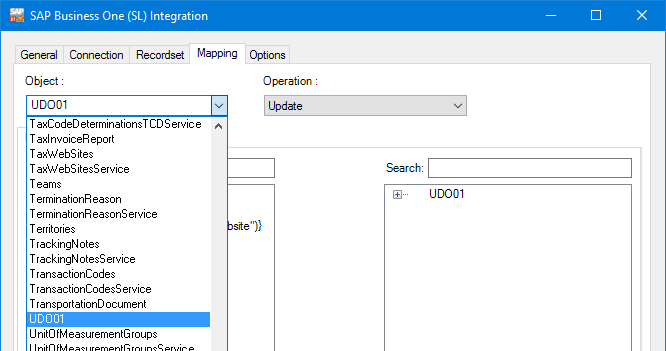
Each user-defined object contains the mandatory operations Add and Update, along with any other operation defined during its creation.
Any user-defined object that has the Log option enabled in SAP Business One has access to history data. Using the SAP Business One (SL) Integration tool, you can retrieve the previous value of a field after an update occurs by mapping a variable to it.
About User-Defined Fields
The SAP Business One (SL) Integration tool supports the use of user-defined fields in both objects and sub-objects. The field is prefixed with U_.
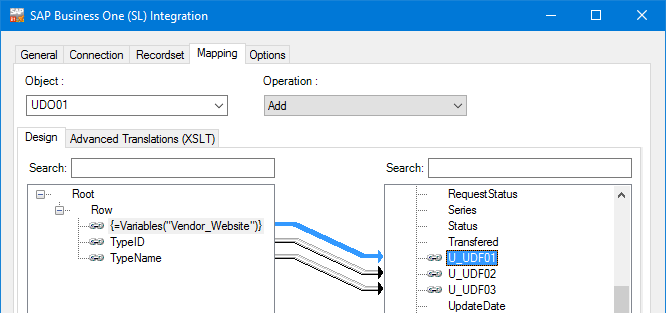
Supported Objects
The objects and operations currently available are shown in the table below, where:
| Key for Standard Operations | |
|---|---|
A — Add | GK — GetByKey |
Ca — Cancel | GL — GetList |
Cl — Close | S — Search |
D — Delete | U — Update |
| SAP B1 Objects | Standard Operations | Comments | |||||||
|---|---|---|---|---|---|---|---|---|---|
| A | U | GK | GL | D | S | Ca | CI | ||
| AccountCategory | |||||||||
| AccountCategoryService | Single supported operation: GetCategoryList | ||||||||
| AccountSegmentationCategories | |||||||||
| AccountSegmentations | |||||||||
| AccountsService | Single supported operation: CreateOpenBalance | ||||||||
| AccrualTypes | |||||||||
| AccrualTypesService | Single supported operation: GetAccrualTypeList | ||||||||
| Activities | |||||||||
| ActivitiesService | Supported operations: DeleteSingleInstanceFromSeries, GetActivityList, GetListByAttendUser, GetSingleInstanceFromSeries, GetTopNActivityInstances, InitData, UpdateSingleInstanceInSeries | ||||||||
| ActivityLocations | |||||||||
| ActivityRecipientsLists | |||||||||
| ActivityRecipientsListsService | |||||||||
| ActivityStatuses | |||||||||
| ActivitySubjects | |||||||||
| ActivitySubjectService | Supported operations: GetActivitySubjectList, GetListByTypeCode | ||||||||
| ActivityTypes | |||||||||
| AdditionalExpenses | |||||||||
| AlertManagements | |||||||||
| AlternateCatNum | |||||||||
| AlternativeItemsService | Supported operations: AddItem, DeleteItem, GetItem, UpdateItem | ||||||||
| ApprovalRequests | Additional supported operations: CancelApprovalRequest, RestoreApprovalRequest | ||||||||
| SAP B1 Objects | Standard Operations | Comments | |||||||
|---|---|---|---|---|---|---|---|---|---|
| A | U | GK | GL | D | S | Ca | CI | ||
| ApprovalRequestsService | Supported operations: GetAllApprovalRequestsList, GetApprovalRequestList, GetOpenApprovalRequestList | ||||||||
| ApprovalStages | |||||||||
| ApprovalStagesService | Single supported operation: GetApprovalStageList | ||||||||
| ApprovalTemplates | |||||||||
| ApprovalTemplatesService | Single supported operation: GetApprovalTemplateList | ||||||||
| AssetCapitalization | |||||||||
| AssetCapitalizationCreditMemo | |||||||||
| AssetCapitalizationCreditMemoService | |||||||||
| AssetCapitalizationService | |||||||||
| AssetClasses | |||||||||
| AssetClassesService | |||||||||
| AssetDepreciationGroups | |||||||||
| AssetDepreciationGroupsService | |||||||||
| AssetGroups | |||||||||
| AssetGroupsService | |||||||||
| AssetManualDepreciation | |||||||||
| AssetManualDepreciationService | |||||||||
| AssetRetirement | |||||||||
| AssetRetirement | |||||||||
| AssetTransfer | |||||||||
| AssetTransferService | |||||||||
| Attachments2 | |||||||||
| SAP B1 Objects | Standard Operations | Comments | |||||||
|---|---|---|---|---|---|---|---|---|---|
| A | U | GK | GL | D | S | Ca | CI | ||
| AttributeGroups | |||||||||
| AttributeGroupsService | |||||||||
| B1Sessions | |||||||||
| BankChargesAllocationCodes | Additional supported operation: SetDefaultBankChargesAllocationCode | ||||||||
| BankChargesAllocationCodesSer vices | Single supported operation: GetBankChargesAllocationCodeList | ||||||||
| BankPages | |||||||||
| Banks | |||||||||
| BankStatements | |||||||||
| BanksStatementsService | Single supported operation: GetBankStatementList | ||||||||
| BarCodes | |||||||||
| BarCodesService | |||||||||
| BatchNumberDetails | |||||||||
| BillOfExchangeTransations | |||||||||
| BinLocationAttributes | |||||||||
| BinLocationAttributesService | |||||||||
| BinLocationFields | |||||||||
| BinLocationFieldsService | |||||||||
| BinLocations | |||||||||
| BinLocationsService | |||||||||
| BlanketAgreements | Additional supported operations: CancelBlanketAgreement, GetRelatedDocuments | ||||||||
| BlanketAgreementsService | Single supported operation: GetBlanketAgreementList | ||||||||
| SAP B1 Objects | Standard Operations | Comments | |||||||
|---|---|---|---|---|---|---|---|---|---|
| A | U | GK | GL | D | S | Ca | CI | ||
| BOEDoumentTypes | |||||||||
| BOEDoumentTypesService | Single supported operation: GetBOEDocumentTypeList | ||||||||
| BOEInstructions | |||||||||
| BOEInstructionsService | Single supported operation: GetBOEInstructionList | ||||||||
| BOELinesService | Single supported operation: GetBOELine | ||||||||
| BOEPortfolios | |||||||||
| BOEPortfoliosService | Single supported operation: GetBOEPortfolioList | ||||||||
| BPOpeningBalanceService | Single supported operation: CreateOpenBalance | ||||||||
| BPPriorities | |||||||||
| Branches | |||||||||
| BranchesService | Single supported operation: GetBranchList | ||||||||
| BrazilBeverageIndexers | |||||||||
| BrazilBeverageIndexersService | |||||||||
| BrazilFuelIndexers | |||||||||
| BrazilFuelIndexersServices | |||||||||
| BrazilMultiIndexers | Additional supported operation: GetIndexerTypeList | ||||||||
| BrazilNumericIndexers | Additional supported operation: GetIndexerTypeList | ||||||||
| BrazilStringIndexers | Additional supported operation: GetIndexerTypeList | ||||||||
| BudgetDistributions | |||||||||
| Budgets | |||||||||
| SAP B1 Objects | Standard Operations | Comments | |||||||
|---|---|---|---|---|---|---|---|---|---|
| A | U | GK | GL | D | S | Ca | CI | ||
| BudgetScenarios | |||||||||
| BusinessPartnerGroups | |||||||||
| BusinessPartnerProperties | |||||||||
| BusinessPartnerPropertiesService | Single supported operation: GetBusinessPartnerPropertyList | ||||||||
| BusinessPartners | |||||||||
| BusinessPartnersService | Supported operations: CreateOpenBalance, InitData | ||||||||
| BusinessPlaces | |||||||||
| CampaignResponseType | |||||||||
| CampaignResponseTypeService | Single supported operation: GetResponseTypeList | ||||||||
| Campaigns | |||||||||
| CampaignsService | |||||||||
| CashDiscounts | |||||||||
| CashDiscountsService | Single supported operation: GetCashDiscountList | ||||||||
| CashFlowLineItems | |||||||||
| CashFlowLineItemsService | Single supported operation: GetCashFlowLineItemList | ||||||||
| CertificateSeries | |||||||||
| CertificateSeriesService | Single supported operation: GetCertificateSeriesList | ||||||||
| ChangeLogsService | Supported operations: GetChangeLog, GetChangeLogDifferences | ||||||||
| ChartOfAccounts | |||||||||
| SAP B1 Objects | Standard Operations | Comments | |||||||
|---|---|---|---|---|---|---|---|---|---|
| A | U | GK | GL | D | S | Ca | CI | ||
| CheckLinesService | Supported operations: GetCheckLine, GetValidCheckLineList | ||||||||
| ChecksforPayment | |||||||||
| ChooseFromList | |||||||||
| Cockpits | |||||||||
| CockpitsService | Supported operations: GetCockpitList, GetTemplateCockpitList, GetUserCockpitList, PublishCockpit | ||||||||
| CommissionGroups | |||||||||
| CompanyService | Supported operations: CreatePeriod, CreatePeriodWithFinanceParams, GetAdminInfo, GetAdvancedGLAccount, GetCompanyInfo, GetFeaturesStatus, GetFinancePeriod, GetFinancePeriods, GetItemPrice, GetPathAdmin, GetPeriod, GetPeriods, RemoveFinancePeriod, RoundDecimal, UpdateAdminInfo, UpdateCompanyInfo, UpdateFinancePeriod, UpdatePathAdmin, UpdatePeriod | ||||||||
| Contacts | |||||||||
| ContractTemplates | |||||||||
| SAP B1 Objects | Standard Operations | Comments | |||||||
|---|---|---|---|---|---|---|---|---|---|
| A | U | GK | GL | D | S | Ca | CI | ||
| CorrectionInvoice | Additional supported operations: CreateCancellationDocument, Reopen | ||||||||
| CorrectionInvoiceReversal | Additional supported operations: CreateCancellationDocument, Reopen | ||||||||
| CorrectionInvoiceReversalService | Supported operations: ExportEWayBill, GetApprovalTemplates, HandleApprovalRequest, InitData | ||||||||
| CorrectionInvoiceService | Supported operations: ExportEWayBill, GetApprovalTemplates, HandleApprovalRequest, InitData | ||||||||
| CorrectionPurchaseInvoice | Additional supported operations: CreateCancellationDocument, Reopen | ||||||||
| CorrectionPurchaseInvoiceReversal | Additional supported operations: CreateCancellationDocument, Reopen | ||||||||
| CorrectionPurchaseInvoiceReversalService | Supported operations: ExportEWayBill, GetApprovalTemplates, HandleApprovalRequest, InitData | ||||||||
| CorrectionPurchaseInvoiceService | Supported operations: ExportEWayBill, GetApprovalTemplates, HandleApprovalRequest, InitData | ||||||||
| CostCenterTypes | |||||||||
| CostCenterTypesService | Single supported operation: GetCostCenterTypeList | ||||||||
| SAP B1 Objects | Standard Operations | Comments | |||||||
|---|---|---|---|---|---|---|---|---|---|
| A | U | GK | GL | D | S | Ca | CI | ||
| CostElements | |||||||||
| CostElementsService | Single supported operation: GetCostElementList | ||||||||
| Countries | |||||||||
| CountriesService | Single supported operation: GetCountryList | ||||||||
| CreditCardPayments | |||||||||
| CreditCards | |||||||||
| CreditLinesService | Supported operations: GetCreditLine, GetValidCreditLineList | ||||||||
| CreditNotes | Additional supported operations: CreateCancellationDocument, Reopen | ||||||||
| CreditNotesService | Supported operations: ExportEWayBill, GetApprovalTemplates, HandleApprovalRequest, InitData, RequestApproveCancellation | ||||||||
| CreditPaymentMethods | |||||||||
| Currencies | |||||||||
| CustomerEquipmentCards | |||||||||
| CustomsDeclaration | |||||||||
| CustomsGroups | |||||||||
| CycleCountDetermines | |||||||||
| CycleCountDeterminesService | |||||||||
| DashboardPackagesService | Single supported operation: ImportDashboardPackage | ||||||||
| DeductionTaxGroups | |||||||||
| SAP B1 Objects | Standard Operations | Comments | |||||||
|---|---|---|---|---|---|---|---|---|---|
| A | U | GK | GL | D | S | Ca | CI | ||
| DeductionTaxHierarchies | |||||||||
| DeductionTaxSubGroups | |||||||||
| DeductionTaxSubGroupsService | Single supported operation: GetDeductionTaxSubGroupList | ||||||||
| DefaultElementsforCR | |||||||||
| DeliveryNotes | Additional supported operations: CreateCancellationDocument, Reopen | ||||||||
| DeliveryNotesService | Supported operations: ExportEWayBill, GetApprovalTemplates, HandleApprovalRequest, InitData | ||||||||
| Departments | |||||||||
| DepartmentsService | Single supported operation: GetDepartmentList | ||||||||
| Deposits | Additional supported operations: CancelDeposit, CancelDepositbyCurrentSystemDate | ||||||||
| DepositsService | Supported operations: CancelCheckRow, CancelCheckRowbyCurrentSystem, Date, GetDepositList | ||||||||
| DepreciationAreas | |||||||||
| DepreciationAreasService | |||||||||
| DepreciationTypePools | |||||||||
| DepreciationTypePoolsService | |||||||||
| DepreciationTypes | |||||||||
| DepreciationTypesService | |||||||||
| SAP B1 Objects | Standard Operations | Comments | |||||||
|---|---|---|---|---|---|---|---|---|---|
| A | U | GK | GL | D | S | Ca | CI | ||
| DeterminationCriterias | |||||||||
| DeterminationCriteriasService | |||||||||
| Dimensions | |||||||||
| DimensionsService | Single supported operation: GetDimensionList | ||||||||
| DistributionRules | |||||||||
| DistributionRulesService | Single supported operation: GetDistributionRuleList | ||||||||
| DNFCodeSetup | |||||||||
| DNFCodeSetupService | Single supported operation: GetDNFCodeSetupList | ||||||||
| DownPayments | Additional supported operations: CreateCancellationDocument, Reopen | ||||||||
| DownPaymentsService | Supported operations: ExportEWayBill, GetApprovalTemplates, HandleApprovalRequest, InitData | ||||||||
| Drafts | Additional supported operations: CreateCancellationDocument, Reopen | ||||||||
| DraftsService | Supported operations: ExportEWayBill, GetApprovalTemplates, HandleApprovalRequest, InitData, SaveDraftToDocument | ||||||||
| DunningLetters | |||||||||
| DunningTerms | |||||||||
| DunningTermsService | Single supported operation: GetDunningTermList | ||||||||
| SAP B1 Objects | Standard Operations | Comments | |||||||
|---|---|---|---|---|---|---|---|---|---|
| A | U | GK | GL | D | S | Ca | CI | ||
| DynamicSystemsString | |||||||||
| ElectronicCommunicationActionService | Supported operations: ConfirmSuccessOfCommunication, GetAction, ReportErrorAndContinue, ReportErrorAndStop UpdateAction | ||||||||
| ElectronicCommunicationActionsService | Supported operations: AddEcmAction, AddEcmActionLog, DeleteEcmAction, GetEcmAction, GetEcmActionByDoc, GetEcmActionLog, GetEcmActionLogList, UpdateEcmAction | ||||||||
| ElectronicDocuments | Additional supported operation: GetProtocolParameters | ||||||||
| ElectronicDocumentService | Supported operations: AddLog, ExportEntryLog, GetEntry, GetEntryList, GetLastLog, GetLogs, GetProtocols, UpdateEntry | ||||||||
| ElectronicFileFormats | |||||||||
| ElectronicFileFormatsService | Single supported operation: GetElectronicFileFormatList | ||||||||
| EmailGroups | |||||||||
| EmailGroupsService | |||||||||
| EmployeeIDType | |||||||||
| EmployeeIDTypeService | |||||||||
| SAP B1 Objects | Standard Operations | Comments | |||||||
|---|---|---|---|---|---|---|---|---|---|
| A | U | GK | GL | D | S | Ca | CI | ||
| EmployeePosition | |||||||||
| EmployeePositionService | |||||||||
| EmployeeRolesSetup | |||||||||
| EmployeeRolesSetupService | Single supported operation: GetEmployeeRoleSetupList | ||||||||
| EmployeesInfo | |||||||||
| EmployeeStatus | |||||||||
| EmployeeStatusService | |||||||||
| EmployeeTransfers | |||||||||
| EmployeeTransfersService | Single supported operation: GetEmployeeTransferList | ||||||||
| EnhancedDiscountGroups | |||||||||
| EnhancedDiscountGroupsService | |||||||||
| EWBTransports | |||||||||
| EWBTransporterService | Single supported operation: GetEWBTransporterList | ||||||||
| ExpenseTypes | |||||||||
| ExtendedTranslations | |||||||||
| ExtendedTranslationsService | Single supported operation: GetExtendedTranslationList | ||||||||
| ExternalCallsService | Supported operations: GetCall, SendCall, UpdateCall | ||||||||
| ExternalReconciliationsService | Supported operations: CancelReconciliation, GetReconciliation, GetReconciliationList, Reconcile | ||||||||
| FAAccountDeterminations | |||||||||
| SAP B1 Objects | Standard Operations | Comments | |||||||
|---|---|---|---|---|---|---|---|---|---|
| A | U | GK | GL | D | S | Ca | CI | ||
| FAAccountDeterminationsService | |||||||||
| FactoringIndicators | |||||||||
| FinancialYears | |||||||||
| FinancialYearsService | Single supported operation: GetFinancialYearList | ||||||||
| FiscalPrinter | |||||||||
| FiscalPrinterService | Single supported operation: GetFiscalPrinterList | ||||||||
| FixedAssetItemsService | Supported operations: GetAssetEndBalance, GetAssetValuesList, UpdateAssetEndBalance | ||||||||
| FormattedSearches | |||||||||
| FormPreferences | |||||||||
| Forms1099 | |||||||||
| GLAccountAdvancedRules | |||||||||
| GLAccountAdvancedRulesService | |||||||||
| GoodsReturnRequest | Additional supported operations: CreateCancellationDocument, Reopen | ||||||||
| GoodsReturnRequestService | Supported operations: ExportEWayBill, GetApprovalTemplates, HandleApprovalRequest, InitData | ||||||||
| GovPayCodes | |||||||||
| GovPayCodesService | |||||||||
| GTIsService | Single supported operation: Import | ||||||||
| HouseBankAccounts | |||||||||
| SAP B1 Objects | Standard Operations | Comments | |||||||
|---|---|---|---|---|---|---|---|---|---|
| A | U | GK | GL | D | S | Ca | CI | ||
| IncomingPayments | Additional supported operations: CancelbyCurrentSystemDate, GetApprovalTemplates, SaveDraftToDocument | ||||||||
| IndiaSacCode | |||||||||
| IndiaSacCodeService | |||||||||
| Industries | |||||||||
| IntegrationPackagesConfigure | |||||||||
| IntegrationPackagesConfigureService | |||||||||
| InternalReconciliations | Additional supported operation: RequestApproveCancellation | ||||||||
| InternalReconciliationsService | Single supported operation: GetOpenTransactions | ||||||||
| IntrastatConfiguration | |||||||||
| IntrastatConfigurationService | |||||||||
| InventoryCountings | |||||||||
| InventoryCountingsService | |||||||||
| InventoryCycles | |||||||||
| InventoryGenEntries | Additional supported operations: CreateCancellationDocument, Reopen | ||||||||
| InventoryGenEntriesService | Supported operations: ExportEWayBill, GetApprovalTemplates, HandleApprovalRequest, InitData | ||||||||
| InventoryGenExits | Additional supported operations: CreateCancellationDocument, Reopen | ||||||||
| SAP B1 Objects | Standard Operations | Comments | |||||||
|---|---|---|---|---|---|---|---|---|---|
| A | U | GK | GL | D | S | Ca | CI | ||
| InventoryGenExitService | Supported operations: ExportEWayBill, GetApprovalTemplates, HandleApprovalRequest, InitData | ||||||||
| InventoryOpeningBalances | |||||||||
| InventoryOpeningBalancesService | |||||||||
| InventoryPostings | |||||||||
| InventoryPostingsService | Additional supported operation: SetCopyOption | ||||||||
| InventoryTransferRequests | Additional supported operations: SaveDraftToDocument | ||||||||
| InventoryTransferRequestsService | Supported operations: GetApprovalTemplates, HandleApprovalRequest | ||||||||
| Invoices | Additional supported operations: CreateCancellationDocument, Reopen | ||||||||
| InvoicesService | Supported operations: ExportEWayBill, GetApprovalTemplates, HandleApprovalRequest, InitData | ||||||||
| ItemGroups | |||||||||
| ItemImages | |||||||||
| ItemProperties | |||||||||
| Items | |||||||||
| ItemService | Single supported operation: InitData | ||||||||
| JournalEntries | |||||||||
| JournalEntryDocumentTypes | |||||||||
| SAP B1 Objects | Standard Operations | Comments | |||||||
|---|---|---|---|---|---|---|---|---|---|
| A | U | GK | GL | D | S | Ca | CI | ||
| JournalEntryDocumentTypeService | |||||||||
| JournalVouchersService | |||||||||
| KnowledgeBaseSolutions | |||||||||
| KPIs | |||||||||
| KPIsService | |||||||||
| LandedCosts | Additional supported operations: CancelLandedCost, CloseLandedCost | ||||||||
| LandedCostsCodes | |||||||||
| LandedCostsService | Single supported operation: GetLandedCostList | ||||||||
| LegalData | |||||||||
| LengthMeasures | |||||||||
| LicenseService | Single supported operation: GetInstallationNumber | ||||||||
| LocalEra | |||||||||
| Manufacturers | |||||||||
| MaterialGroups | |||||||||
| MaterialGroupsService | Single supported operation: GetMaterialGroupList | ||||||||
| MaterialRevaluation | |||||||||
| MaterialRevaluationFIFOService | |||||||||
| MaterialRevaluationSNBService | |||||||||
| Messages | |||||||||
| MessagesService | Supported operations: GetInbox, GetOutbox, GetSentMessages | ||||||||
| SAP B1 Objects | Standard Operations | Comments | |||||||
|---|---|---|---|---|---|---|---|---|---|
| A | U | GK | GL | D | S | Ca | CI | ||
| MobileAddOnSetting | |||||||||
| MobileAddOnSettingService | Single supported operation: GetMobileAddOnSettingList | ||||||||
| MobileAddService | Supported operations: GetCurrentServerDateTime, GetDppChangeParams[SIC], GetEmployeeFullNames,GetSalesAppSetting, GetServiceAppReport, GetServiceAppReportContent, GetTechnicianSchedulings, GetTechnicianSettings, GetTechnicianSettingsGroup, UpdateSalesAppSetting, UpdateServiceAppReport, UpdateServiceAppReportContent, UpdateTechnicianSettings, UpdateTechnicianSettingsGroup | ||||||||
| MultiLanguageTranslations | |||||||||
| NatureOfAssessees | |||||||||
| NatureOfAssesseesService | Single supported operation: GetNatureOfAssesseeList | ||||||||
| NCMCodesSetup | |||||||||
| NCMCodesSetupService | Single supported operation: GetNCMCodeSetupList | ||||||||
| NFModels | |||||||||
| NFModelsService | |||||||||
| NFTaxCategories | |||||||||
| NFTaxCategoriesServices | |||||||||
| OccurrenceCodes | |||||||||
| OccurrenceCodesService | |||||||||
| SAP B1 Objects | Standard Operations | Comments | |||||||
|---|---|---|---|---|---|---|---|---|---|
| A | U | GK | GL | D | S | Ca | CI | ||
| Orders | Additional supported operations: CreateCancellationDocument, Reopen | ||||||||
| OrdersService | Supported operations: ExportEWayBill, GetApprovalTemplates, HandleApprovalRequest, InitData, Preview | ||||||||
| PackagesTypes | |||||||||
| PartnersSetups | |||||||||
| PartnersSetupsService | |||||||||
| PaymentBlocks | |||||||||
| PaymentBlocksService | Single supported operation: GetPaymentBlockList | ||||||||
| PaymentCalculationService | Single supported operation: GetPaymentAmount | ||||||||
| PaymentDrafts | Additional supported operations: CancelbyCurrentSystemsDate, GetApprovalTemplates, RequestApproveCancellation, SaveDraftToDocument | ||||||||
| PaymentRunExport | |||||||||
| PaymentTermsTypes | |||||||||
| PaymentTermsTypesService | Single supported operation: UpdateWithBPs | ||||||||
| PickLists | Single supported operation: UpdateWithBPs | ||||||||
| PickListsService | Additional supported operation: UpdateReleasedAllocation | ||||||||
| POSDailySummary | |||||||||
| PostingTemplates | |||||||||
| SAP B1 Objects | Standard Operations | Comments | |||||||
|---|---|---|---|---|---|---|---|---|---|
| A | U | GK | GL | D | S | Ca | CI | ||
| PostingTemplatesService | |||||||||
| PredefinedTexts | |||||||||
| PredefinedTextsService | Single supported operation: GetPredefinedTextList | ||||||||
| PriceLists | |||||||||
| ProductionOrders | |||||||||
| ProductTrees | |||||||||
| ProfitCenters | |||||||||
| ProfitCentersService | Single supported operation: GetProfitCenterList | ||||||||
| ProjectManagementConfigurationService | Supported operations: AddActivities, AddAreas, AddPriorities, AddStageTypes, AddSubprojectTypes, AddTasks, DeleteActivities, DeleteAreas, DeletePriorities, DeleteStageTypes, DeleteSubprojectTypes, DeleteTasks, GetActivities, GetAreas, GetPriorities, GetStageTypes, GetSubprojectTypes, GetTasks, UpdateActivities, UpdateAreas, UpdatePriorities, UpdateStageType, UpdateSubprojectTypes, UpdateTasks | ||||||||
| SAP B1 Objects | Standard Operations | Comments | |||||||
|---|---|---|---|---|---|---|---|---|---|
| A | U | GK | GL | D | S | Ca | CI | ||
| ProjectManagements | Additional supported object: CancelProject | ||||||||
| ProjectManagementsService | Supported operations: AddSubproject, DeleteSubproject, GetSubproject, GetSubprojectsList, UpdateSubproject | ||||||||
| ProjectManagementTimeSheet | |||||||||
| Projects | |||||||||
| ProjectsService | Single supported operation: GetProjectList | ||||||||
| PurchaseCreditNotes | Additional supported operations: CreateCancellationDocument, Reopen | ||||||||
| PurchaseCreditNotesService | Supported operations: ExportEWayBill, GetApprovalTemplates, HandleApprovalRequest, InitData | ||||||||
| PurchaseDeliveryNotes | Additional supported operations: CreateCancellationDocument, Reopen | ||||||||
| PurchaseDeliveryNotesService | Supported operations: ExportEWayBill, GetApprovalTemplates, HandleApprovalRequest, InitData | ||||||||
| PurchaseDownPayments | Additional supported operations: CreateCancellationDocument, Reopen | ||||||||
| SAP B1 Objects | Standard Operations | Comments | |||||||
|---|---|---|---|---|---|---|---|---|---|
| A | U | GK | GL | D | S | Ca | CI | ||
| PurchaseDownPaymentsService | Supported operations: ExportEWayBill, GetApprovalTemplates, HandleApprovalRequest, InitData | ||||||||
| PurchaseInvoices | Additional supported operations: CreateCancellationDocument, Reopen | ||||||||
| PurchaseInvoicesService | Supported operations: ExportEWayBill, GetApprovalTemplates, HandleApprovalRequest, InitData | ||||||||
| PurchaseOrders | Additional supported operations: CreateCancellationDocument, Reopen | ||||||||
| PurchaseOrdersService | Supported operations: ExportEWayBill, GetApprovalTemplates, HandleApprovalRequest, InitData | ||||||||
| PurchaseQuotations | Additional supported operations: CreateCancellationDocument, Reopen | ||||||||
| PurchaseQuotationsService | Supported operations: ExportEWayBill, GetApprovalTemplates, HandleApprovalRequest, InitData | ||||||||
| PurchaseRequests | Additional supported operations: CreateCancellationDocument, Reopen | ||||||||
| SAP B1 Objects | Standard Operations | Comments | |||||||
|---|---|---|---|---|---|---|---|---|---|
| A | U | GK | GL | D | S | Ca | CI | ||
| PurchaseRequestsService | Supported operations: ExportEWayBill, GetApprovalTemplates, HandleApprovalRequest, InitData | ||||||||
| PurchaseReturns | Additional supported operations: CreateCancellationDocument, Reopen | ||||||||
| PurchaseReturnsService | Supported operations: ExportEWayBill, GetApprovalTemplates, HandleApprovalRequest, InitData | ||||||||
| PurchaseTaxInvoices | |||||||||
| QRCodeService | Single supported operation: AddOrUpdateQRCode | ||||||||
| QueryAuthGroups | |||||||||
| QueryAuthGroupsService | Single supported operation: GetQueryAuthGroupList | ||||||||
| QueryCategories | |||||||||
| QueryService | Single supported operation: PostQuery | ||||||||
| Queue | |||||||||
| Quotations | Additional supported operations: CreateCancellationDocument, Reopen | ||||||||
| QuotationsService | Supported operations: ExportEWayBill, GetApprovalTemplates, HandleApprovalRequest, InitData | ||||||||
| RecurringPostings | |||||||||
| RecurringPostingsService | |||||||||
| SAP B1 Objects | Standard Operations | Comments | |||||||
|---|---|---|---|---|---|---|---|---|---|
| A | U | GK | GL | D | S | Ca | CI | ||
| RecurringTransactionService | Supported operations: DeleteRecurringTransactions, ExecuteRecurringTransactions, GetAvailableRecurringTransactions, GetRecurringTransactions | ||||||||
| Relationships | |||||||||
| ReportFilter | |||||||||
| ReportFilterService | Single supported operation: GetTaxReportFilterList | ||||||||
| ReportLayoutsService | Supported operations: AddReportLayout, AddReportLayoutToMenu, DeleteReportLayout, DeleteReportLayoutAndMenu, GetDefaultReport, GetDefaultReportLayout, GetReportLayout, GetReportLayoutList, SetDefaultReport, UpdateLanguageReport, UpdatePrinterSettings | ||||||||
| ReportTypes | |||||||||
| ReportTypesService | Single supported operation: GetReportTypeList | ||||||||
| ResourceCapabilities | |||||||||
| ResourceCapabilitiesService | Additional supported operation: GetListWithFilter | ||||||||
| ResourceGroups | |||||||||
| ResourceGroupsService | |||||||||
| ResourceProperties | |||||||||
| ResourcePropertiesService | |||||||||
| SAP B1 Objects | Standard Operations | Comments | |||||||
|---|---|---|---|---|---|---|---|---|---|
| A | U | GK | GL | D | S | Ca | CI | ||
| Resources | Additional supported operation: CreateLinkedItem | ||||||||
| ResourcesService | |||||||||
| RetornoCodes | |||||||||
| RetornoCodesService | |||||||||
| ReturnRequest | Additional supported operations: CreateCancellationDocument, Reopen | ||||||||
| ReturnRequestService | Supported operations: ExportEWayBill, GetApprovalTemplates, HandleApprovalRequest, InitData | ||||||||
| Returns | Additional supported operations: CreateCancellationDocument, Reopen | ||||||||
| ReturnsService | Supported operations: ExportEWayBill, GetApprovalTemplates, HandleApprovalRequest, InitData | ||||||||
| RouteStages | |||||||||
| RouteStagesService | |||||||||
| RoutingDataCalculationService | Single supported operation: Calculate | ||||||||
| SalesForecast | |||||||||
| SalesOpportunities | |||||||||
| SalesOpportunityCompetitorsSetup | |||||||||
| SalesOpportunityCompetitorsSetupService | Single supported operation: GetSalesOpportunityCompetitor, SetupList | ||||||||
| SAP B1 Objects | Standard Operations | Comments | |||||||
|---|---|---|---|---|---|---|---|---|---|
| A | U | GK | GL | D | S | Ca | CI | ||
| SalesOpportunityInterestsSetup | |||||||||
| SalesOpportunityInterestsSetupService | Single supported operation: GetSalesOpportunityInterestSetupList | ||||||||
| SalesOpportunityReasonsSetup | |||||||||
| SalesOpportunityReasonsSetupService | Single supported operation: GetSalesOpportunityReasonsSetupList | ||||||||
| SalesOpportunitySourcesSetup | |||||||||
| SalesOpportunitySourcesSetupService | Single supported operation: GetSalesOpportunitySourceSetupList | ||||||||
| SalesPersons | |||||||||
| SalesStages | |||||||||
| SalesTaxAuthorities | |||||||||
| SalesTaxAuthoritiesTypes | |||||||||
| SalesTaxCodes | |||||||||
| SalesTaxInvoices | |||||||||
| SBOBobService | Supported operations: MoneyToString, GetCurrencyRate, GetDueDate, GetIndexRate, GetLocalCurrency, GetSystemCurrency, GetSystemPermission, SetCurrencyRate | ||||||||
| Sections | |||||||||
| SectionsService | Single supported operation: GetSectionList | ||||||||
| SAP B1 Objects | Standard Operations | Comments | |||||||
|---|---|---|---|---|---|---|---|---|---|
| A | U | GK | GL | D | S | Ca | CI | ||
| SensitiveDataAccessService | Supported opertions: Access, IsDataSensitive | ||||||||
| SerialNumberDetails | |||||||||
| SeriesService | Supported operations: AddElectronicSeries, AddSeries, AttachSeriesToDocument, ChangeDocumentMenuName, GetDefaultElectronicSeries, GetDefaultSeries, GetDocumentChangedMenuName, GetDocumentSeries, GetElectronicSeries, GetSeries, RemoveElectronicSeries, RemoveSeries, SetDefaultElectronicSeries, SetDefaultSeriesForAllUsers, SetDefaultSeriesForCurrentUser, SetDefaultSeriesForUser, UnattachSeriesFromDocument, UpdateElectronicSeries, UpdateSeries | ||||||||
| ServiceCallOrigins | |||||||||
| ServiceCallOriginsService | Single supported operation: GetServiceCallOriginList | ||||||||
| ServiceCallProblemSubTypes | |||||||||
| ServiceCallProblemSubTypeService | Single supported operation: GetServiceCallProblemSubTypeList | ||||||||
| ServiceCallProblemTypes | |||||||||
| ServiceCallProblemTypesService | Single supported operation: GetServiceCallProblemTypeList | ||||||||
| ServiceCalls | |||||||||
| SAP B1 Objects | Standard Operations | Comments | |||||||
|---|---|---|---|---|---|---|---|---|---|
| A | U | GK | GL | D | S | Ca | CI | ||
| ServiceCallSolutionStatus | |||||||||
| ServiceCallSolutionStatusService | Single supported operation: GetServiceCallSolutionStatusList | ||||||||
| ServiceCallStatus | |||||||||
| ServiceCallStatusService | Single supported operation: GetServiceCallStatusList | ||||||||
| ServiceCallTypes | |||||||||
| ServiceCallTypesService | Single supported operation: GetServiceCallTypeList | ||||||||
| ServiceContracts | |||||||||
| ServiceGlobalActions | Supported operations: Login, Logout | ||||||||
| ServiceGroups | |||||||||
| ServiceGroupsService | Single supported operation: GetServiceGroupList | ||||||||
| ServiceTaxPostingService | Supported operations: GetTaxableDeliveries, PostServiceTax | ||||||||
| ShippingTypes | |||||||||
| SingleUserConnections | |||||||||
| SpecialPrices | |||||||||
| SQLViews | |||||||||
| States | |||||||||
| StatesService | Single supported operation: GetStateList | ||||||||
| StockTakings | |||||||||
| SAP B1 Objects | Standard Operations | Comments | |||||||
|---|---|---|---|---|---|---|---|---|---|
| A | U | GK | GL | D | S | Ca | CI | ||
| StockTransferDrafts | Additional supported operation: SaveDraftToDocument | ||||||||
| StockTransferDraftsService | Supported operations: GetApprovalTemplates, HandleApprovalRequest | ||||||||
| StockTransfers | Additional supported operation: SaveDraftToDocument | ||||||||
| StockTransferService | Supported operations: GetApprovalTemplates, HandleApprovalRequest | ||||||||
| TargetGroups | |||||||||
| TargetGroupsService | |||||||||
| TaxCodeDeterminations | |||||||||
| TaxCodeDeterminationsService | Single supported operation: GetTaxCodeDeterminationList | ||||||||
| TaxCodeDeterminationsTCD | |||||||||
| TaxCodeDeterminationsTCDService | Single supported operation: GetTaxCodeDeterminationTCDList | ||||||||
| TaxInvoiceReport | Additional supported operation: CancelTaxInvoiceReport | ||||||||
| TaxWebSites | Additional supported operation: SetAsDefault | ||||||||
| TaxWebSitesService | Supported operations: GetDefaultWebSite, GetTaxWebSiteList | ||||||||
| Teams | |||||||||
| TerminationReason | |||||||||
| TerminationReasonService | |||||||||
| Territories | |||||||||
| TrackingNotes | |||||||||
| SAP B1 Objects | Standard Operations | Comments | |||||||
|---|---|---|---|---|---|---|---|---|---|
| A | U | GK | GL | D | S | Ca | CI | ||
| TrackingNotesService | |||||||||
| TransactionCodes | |||||||||
| TransactionCodesService | |||||||||
| TransportationDocument | Additional supported operation: CancelTransportationDocument | ||||||||
| UnitOfMeasurementGroups | |||||||||
| UnitOfMeasurementGroupsService | |||||||||
| UnitOfMeasurements | |||||||||
| UnitOfMeasurementsService | |||||||||
| UserDefaultGroups | |||||||||
| UserFieldsMD | |||||||||
| UserGroups | |||||||||
| UserGroupsService | Single supported operation: GetUserGroupList | ||||||||
| UserKeysMD | |||||||||
| UserLanguages | |||||||||
| UserMenuService | Supported operations: GetCurrentUserMenu, GetUserMenu, UpdateCurrentUserMenu, UpdateUserMenu | ||||||||
| UserObjectsMD | |||||||||
| UserPermissionTree | |||||||||
| UserQueries | |||||||||
| Users | |||||||||
| UserTablesMD | |||||||||
| ValueMapping | |||||||||
| SAP B1 Objects | Standard Operations | Comments | |||||||
|---|---|---|---|---|---|---|---|---|---|
| SAP B1 Objects | Standard Operations | Comments | |||||||
| A | U | GK | GL | D | S | Ca | CI | ||
| ValueMappingCommunication | |||||||||
| ValueMappingService | Supported operations: GetMappedB1Vlaue, GetThirdPartyValuesForB1Value, RemovedMappedValue | ||||||||
| VatGroups | |||||||||
| VendorPayments | Additional supported operations: CancelbyCurrentSystemDate, GetApprovalTemplates, RequestApproveCancellation, SaveDraftToDocument | ||||||||
| WarehouseLocations | |||||||||
| Warehouses | |||||||||
| WarehouseSublevelCodes | |||||||||
| WarehouseSublevelCodesService | |||||||||
| WebClientBookmarkTiles | |||||||||
| WebClientBookmarkTilesService | |||||||||
| WebClientDashboards | |||||||||
| WebClientDashboardService | |||||||||
| WebClientFormSettings | |||||||||
| WebClientFormSettingService | |||||||||
| WebClientLaunchpads | |||||||||
| WebClientLaunchpadService | |||||||||
| WebClientListviewFilters | |||||||||
| WebClientListviewFilterService | |||||||||
| WebClientNotifications | |||||||||
| WebClientNotificationService | |||||||||
| WebClientPreferences | |||||||||
| SAP B1 Objects | Standard Operations | Comments | |||||||
|---|---|---|---|---|---|---|---|---|---|
| A | U | GK | GL | D | S | Ca | CI | ||
| WebClientPreferenceService | |||||||||
| WebClientRecentActivities | |||||||||
| WebClientRecentActivityServices | |||||||||
| WebClientVariantGroups | |||||||||
| WebClientVariantGroupService | |||||||||
| WebClientVariants | |||||||||
| WebClientVariantService | |||||||||
| WeightMeasures | |||||||||
| WithholdingTaxCodes | |||||||||
| WitholdingTaxDefinition[SIC] | |||||||||
| WizardPaymentMethods | |||||||||
| WorkflowTaskService | Supported operations: Complete, GetApprovalTaskList | ||||||||
About the Options Tab
The Options tab allows you to define how errors in this step are handled at task runtime.

If an error occurs, you can decide whether the step should Continue processing, or terminate the step immediately (Abort Step).
If the step is aborted, you can choose to Continue processing onto the next step in the task, or terminate the whole task immediately (Abort Task). By allowing the task to Continue, you can use the error XML received back in a Save File step for investigation purposes, for example.